There Are Many Types Of Dress Shoes
Welcome to the Ultimate Guide about the different Types of Men’s Dress Shoes.
An in-depth guide written by a real shoe enthusiast that will help you gain true knowledge about more than just the basics.
Most guides focus on the same few generic models but even fewer expand on each category.
Whether you seek knowledge about oxfords, loafers, brogues and monkey boots you will find it here.
Let’s begin!
Why Good Shoes Are Important
A good pair of shoes will complement your outfit and elevate it to the next level. It shows that you care about your appearance.
Personally I care about what I put on my feet and so should you. On the other hand a cheap, plastic shoe from Zara or those oversized ugly sneakers will make even the most expensive suit look bad.
Whether you intend to do business or leisure you should try to collect shoes that are appropriate for each social situation.
However a common problem is that there are so many types of dress shoes out there and so little actual information.
Today, we are going to solve that problem together.
1. Read These Guides After You Finish This
There are two key areas that you should understand before buying dress shoes.
The different Methods of Shoe Construction and Types of Shoe Leather. I have some very comprehensive Guides for both of them:
When you do your due diligence you will know exactly what you are buying and what to choose.
Bookmark them and share them so you can always fall back to it if needed.
1.1 Shoe Construction
When you binge on the Guide above you will notice there are quite a few shoe construction methods.
However is only one undisputed king of shoe construction and that is the Goodyear Welted Method.
By undisputed, I don’t mean “Best” as there are many construction methods and each has its merit. What I do mean is that it is the most popular, solid construction out there for good shoes.



A technique developed by Charles Goodyear Jr. that uses a strip of leather on the perimeter of the outsole and connects the uppers to the sole in two key points.
By far the most solid and popular construction, it allows the wearer to resole their shoes with low effort and prolong their life.
Each shoemaking house has their own trademark constructions but the key here is this:
Even if your budget is small, there is no reason not to have at least Blake Stitched Shoes in 2021.
An entry level Goodyear Welted Shoe will cost you around $160 in 2021.
1.2 Shoe Leather
In Guides across the internet you will often see people promoting terrible shoes but quoting they are Goodyear Welted.
Judging by the previous paragraph, that’s a good thing right? Yes and No.
Even if the construction is solid if you use cheap materials and low quality leather your shoes will soon be worthless.
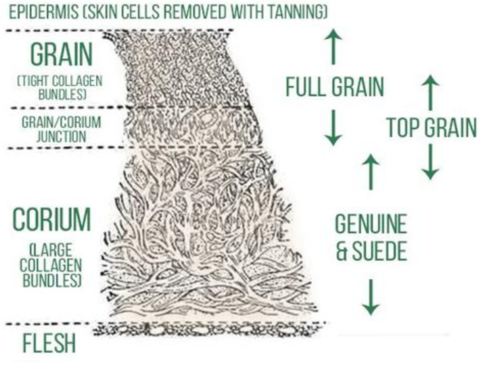


How many times did you buy shoes that looked decent yet after a couple of wears the leather appears cracked or completely loses shape?
Your aim – depending on the style you like – would generally be full grain calfskin leather or quality suede.
Read the Guide above to understand the properties of each leather and how to spot the fake ones.
Be extremely careful for those that quote just “Genuine Leather”.
1.3 Good Shoes Are More Sustainable
When you buy cheap shoes you will throw them away in 6-12 months.
Good shoes are more sustainable as you keep them and refurbish them.
Additionally, it is important to understand that leather is a bi-product of the meat industry. We never skin animals just for their hide (or we shouldn’t).
Instead of wasting the material, why not put it into good use and make a pair of shoes that will last you decades.
However the meat industry is a very dark, volatile place so be very careful. Buy only from reputable sources that disclose their tanneries.
Question: Would you like to read an article about this topic and the bets Tanneries in the world? Let me know in the comments!
2. Types Of Dress Shoes List
What we are going to do first is discuss all the main “Core” Styles and Types of Dress Shoes.
If you are unsure about various words make sure to check out the terminology section later.
2.1 Oxfords
The Oxford is and will always be a menswear classic and appropriate for the most formal of occasions.
It is a lace-up shoe with a closed lacing system. The eyelet tabs are sewn under the vamp of the shoe and form a V shape on the top.
The origin of the Oxford is not entirely clear but the term appeared in the middle of the 19th Century (Source). The development of a more low-profile boot called Oxoniana was the early inspiration for the Oxfords we love today.
While the inventor is unknown (or debatable) the first mention of the term “Oxford Shoe” came from Joseph Sparkes Hall around 1846 (Source).
“The Oxford shoe… is the best shoe for walking. They are tied at the front because they have three or four holes. They are nothing more than what are now called Oxford shoes”.
Joseph Sparkes Hall in The New Monthly Magazine
You can often refer to an Oxford shoe as a Balmoral but in my opinion a Balmoral Oxford takes inspiration from the Balmoral Boot.
In France they use the word “Richelieu” instead of Oxford Shoe.
2.1.1 Cap-Toe Oxfords
The term “Cap-Toe Oxford” is more of a stylistic choice for a shoemaker rather than a style itself. If this makes sense.
That is because a Cap-Toe is not exclusive to Oxfords (it can be a brogue, derby, etc.) however it is the most recognizable style.



A Cap-Toe is a series of horizontal stitching across the toe box of the shoes. It begins at the welt on one side and goes all the way around horizontally.
You create it when you stitch together the different parts of the shoe just before you last it. The stitching can be single, double, triple or whatever you desire.
Usually since the Oxford is a formal shoe it is quite minimalist.
There are even small variations with their own name now such as the “V-Cap” that is a stylistic choice.
Some people prefer to call it a Toe-Cap but that’s up to you.
2.1.2 Plain-Toe Oxfords
Just like it’s brother above, the Plain-Toe Oxford is rather self-explanatory.
In this case the toe box is “plain” without any stitching and a single piece of leather forming that area.
It can be a dangerous stylistic choice as the lack of a Cap-Toe in combination with a more almond shape can create an elongated look.
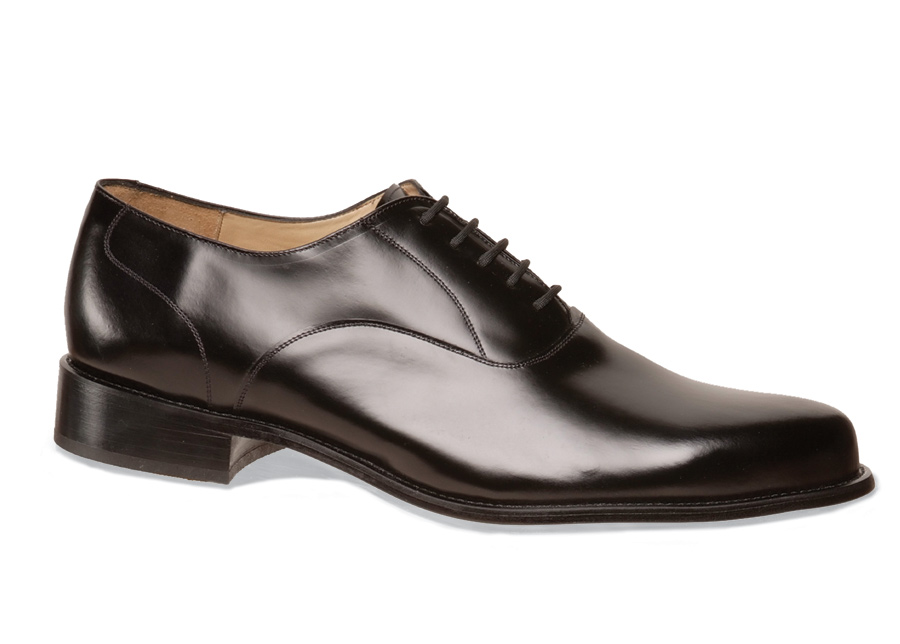


You will seldom encounter Plain-Toe Oxfords in the wild apart from Adelaide Oxfords.
However you should avoid a Classic Oxford without a Cap-Toe as no respectable quality maker will produce them.
Patent Oxfords and Adelaide Oxfords are an exception. Read about them later on this list.
2.1.3 Wholecut Oxford
What happens when you take a Classic Oxford, remove all the stitching and make shoes out of a single piece of leather?
You get a Wholecut Oxford of course! Also known as “One-Cut” in France the Wholecut is a beautiful, minimalist formal type of dress shoe.
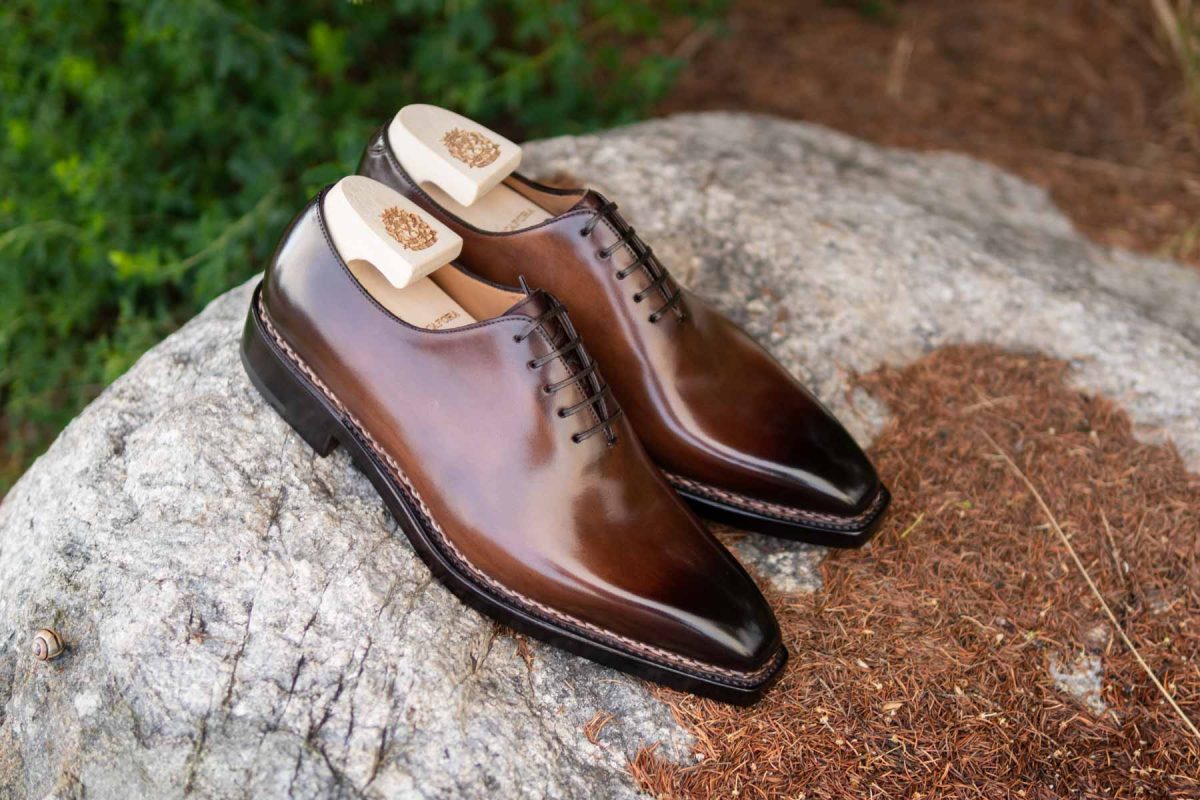

Due to the lack of a Cap-Toe, a Wholecut is a more “delicate” shoe that will show wear and creases a bit more.
It is a beautiful shoe and one of the most formal types of dress shoes you can wear.
2.1.4 Seamless Wholecut Oxford
If you noticed above, the Wholecut has a backseam. A Seamless Wholecut however does not.
While this is the same exact shoe, it deserves its own category due to the skill required.
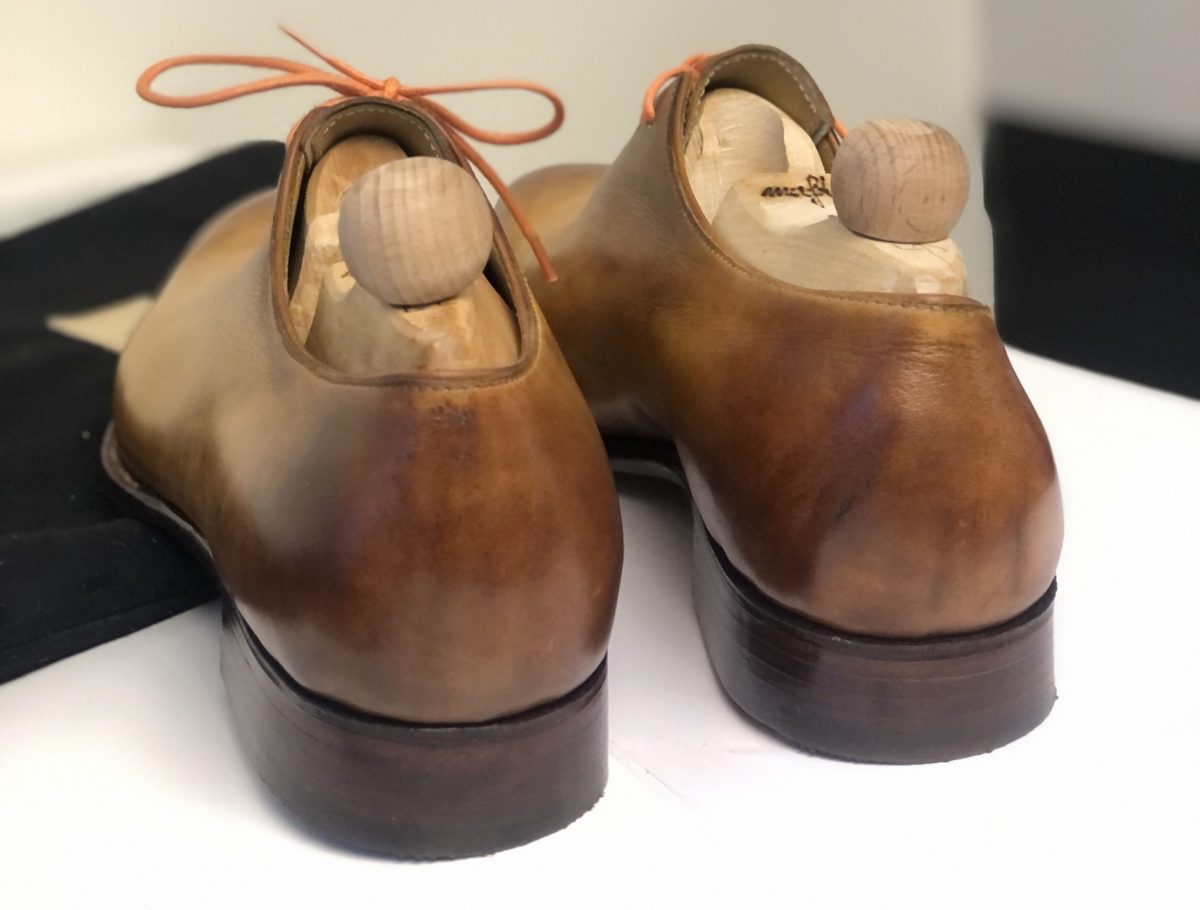


Imagine that you need to cut a piece of leather so perfectly in one go and have the skill to last it without failure.
You will not find this outside Bespoke level quality shoes and it commands a much higher price.
2.1.5 Balmoral Oxford
In the intro we said that it’s ok to say Balmoral Oxford to describe them all.
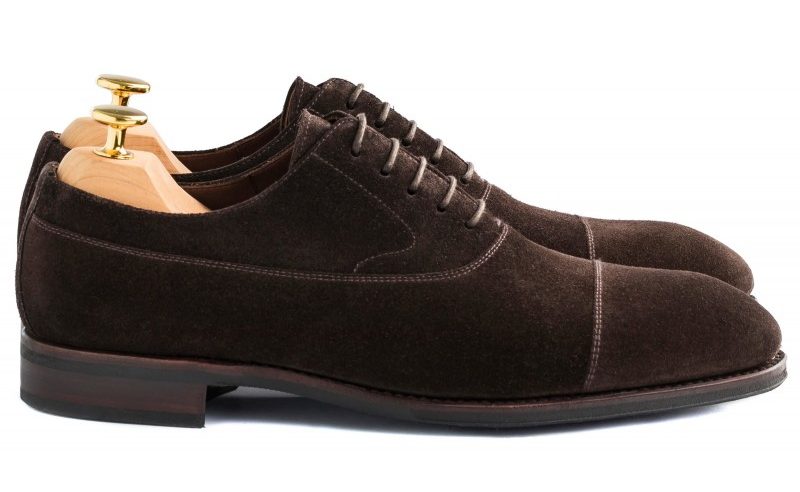


For me however it is a different stylistic choice. I refer to a Balmoral Oxford as a Cap-Toe Oxford but with a seam that runs across the shoe towards the back.
I find Balmoral Oxfords one of the few types of Oxfords that can look great in bi-material.
2.1.6 Side Stitched Oxford
This is essentially yet another variation of a wholecut.
The only difference is that instead of the classic lacing on top of the shoe, you will find it diagonally at an angle.



I haven’t tried one on but there are a few great shoemakers that experiment with the style.
Norman Vilalta and Altan Bottier are some of them. The latter calls this a lateral lace-up.
2.1.7 Adelaide Oxford
We arrive at one of my favorite types of Oxford Shoes: The Adelaide.
An Adelaide Oxford is a Cap-Toe or Plain-Toe Oxford with a “U” shaped throat (or yoke) around the lacing (often with broguing).



It is a very elegant beautiful variation that I personally love.
Great makers from Yohei Fukuda, to TLB Mallorca and Gaziano & Girling make this style.
It looks exceptionally well with a plain tasteful medallion toe.
Credit for the design goes to Terry Moore who is a legendary last maker at Foster & Son.
2.1.8 Lazyman Oxford
Believe it or not, the term “Lazyman” is slang for a Side Gusset Casual.
It looks like an oxford and usually has a lot of broguing, however the lacing is not functional.



A Lazyman is a slip-on type of dress shoe with elastic sides like in Chelsea Boots.
Classic British shoes and according to Crockett & Jones you can even call it a “Cambridge”.
In all honesty this is a rather controversial style for many as it is more casual and might be too dandy for some.
2.1.9 Swan-Neck Oxford
Last but not least we have yet another variation of a Classic Oxford.
At first glance you would not notice any difference however look closely around the facing and you will see what I mean.



The shape of the stitching has a curved shape which resembles a swan’s neck.
Quite an underrepresented styling choice and one that I don’t find so appealing.
2.2 Derbies
A metaphor I like to use is that if the Oxford was Batman, then the Derby would be Robin.
In many ways both shoes are the same, but with a fundamental design/construction difference.
Whereas an Oxford has a closed lacing system, the Derby has an “Open Lacing System“.
The quarters of the shoe are stitched on top of of the vamp as opposed to under.
You can see the throat and the tongue clearly and there is ample space between the laces.
In a bit more detail, the construction of the shoe involves the vamp and tongue as well as two quarters sewn together.
The terms Gibson and Blucher are interchangeable even though they have minor differences.
2.2.1 Cap-Toe Derby
Barring the lacing system, a Cap-Toe Derby is the same shoe as a Cap-Toe Oxford.
However it is less formal and much easier to dress down or up. It still has the horizontal Cap-Toe stitching that runs across the toe area.
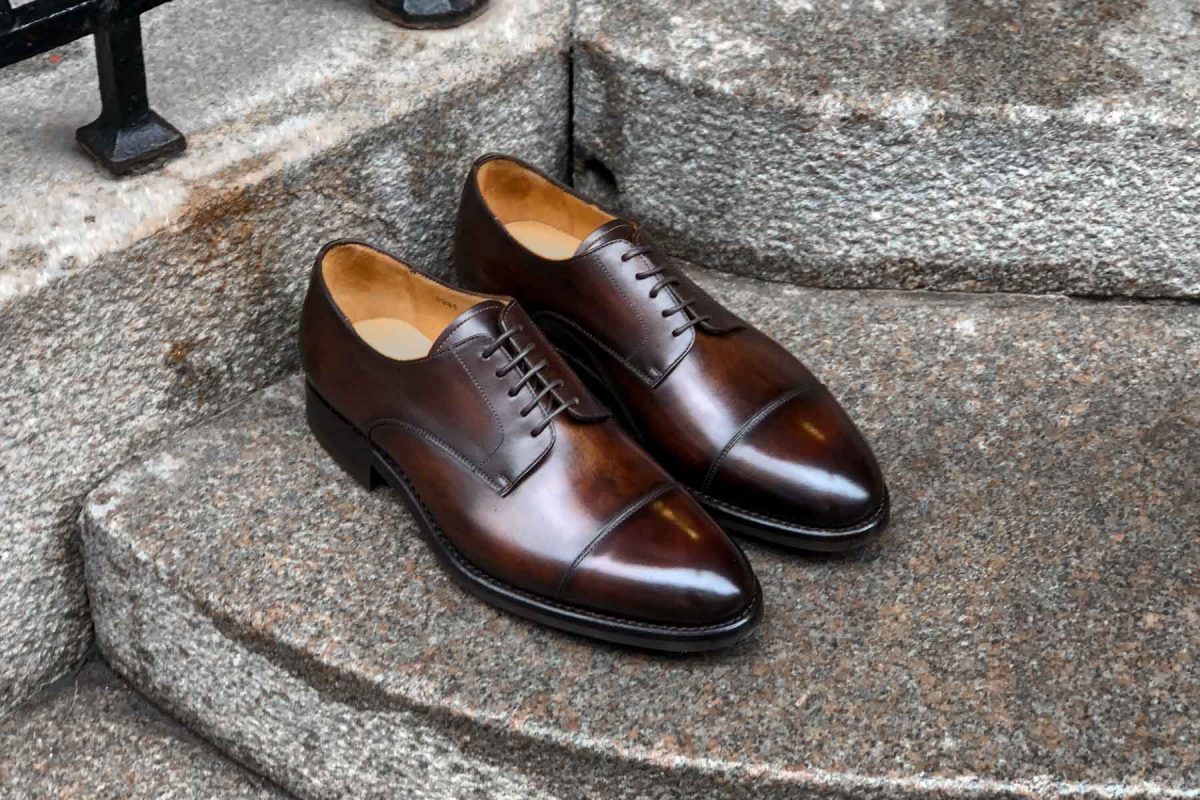


It is definitely one of the most important pieces in a man’s starting wardrobe.
A Cap-Toe Oxford and Derby are some types of dress shoes that you should have.
2.2.2 Plain-Toe Derby
In similar fashion the Plain-Toe Derby has no stitching on the toe area.
However, due to the more casual nature of the style it is a much more popular (and appropriate) design than the oxford version.
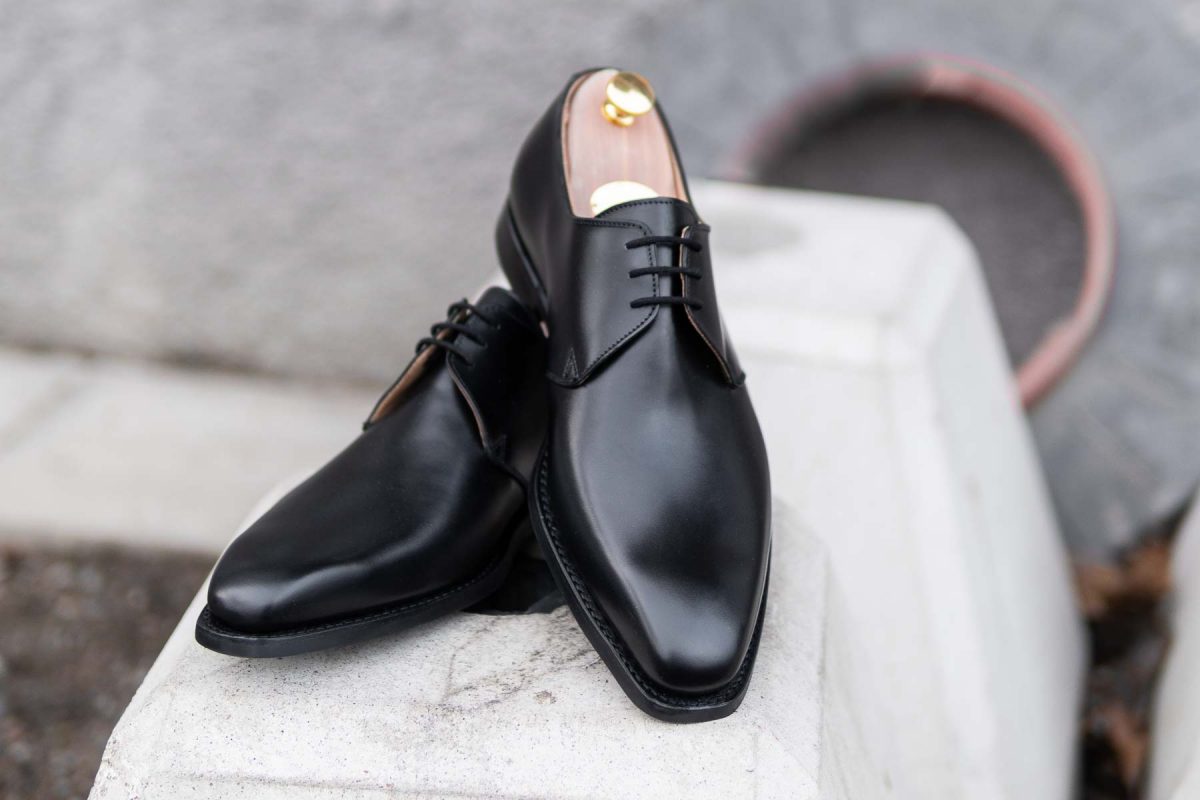


With the exception of some more chiseled toes these often appear in more casual, country or chunky designs.
Think of your average Alden Derby and you will understand what I mean. However these are the ones that you will never see me wearing because I (personally) consider them ugly.
I saw someone argue that there are wholecut derbies but you still stitch the lacing on top so it’s not.
Note: If you don’t agree with me on something or you love a style I don’t it is fine! Wear what you love and think you enjoy there is no right or wrong!
2.2.3 Blucher
There are many stories about these particular types of dress shoes.
A popular one talks about inspiration from Gebhard Leberecht von Blücher who was a Prussian Field Marshal during the Napoleonic wars.
While you can still refer to a Derby as a Blucher, there is a small difference.
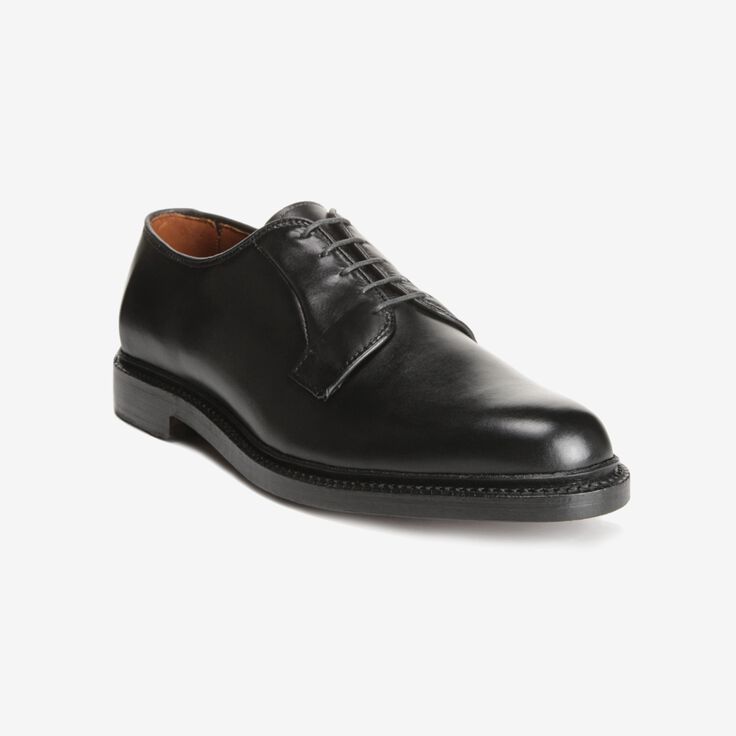


The hallmark of a Blucher is a Plain-Toe shoe with a vamp and tongue (one piece) and the little “Hockey Sticks” sewn on top, creating the lacing system.
2.2.4 Norwegian Split-Toe Derby
The Norwegian Split-Toe Derby – commonly referred to as NST – is a model you either hate or love.
A dress shoe with an open lacing system but with the addition of an apron toe. Think of it as a long U shaped design.
At the end of the toe there is a “Split” that you stitch towards the welt and join everything together. In some cases you can see it with “Skin Stitching” which means they sew it under the hide.
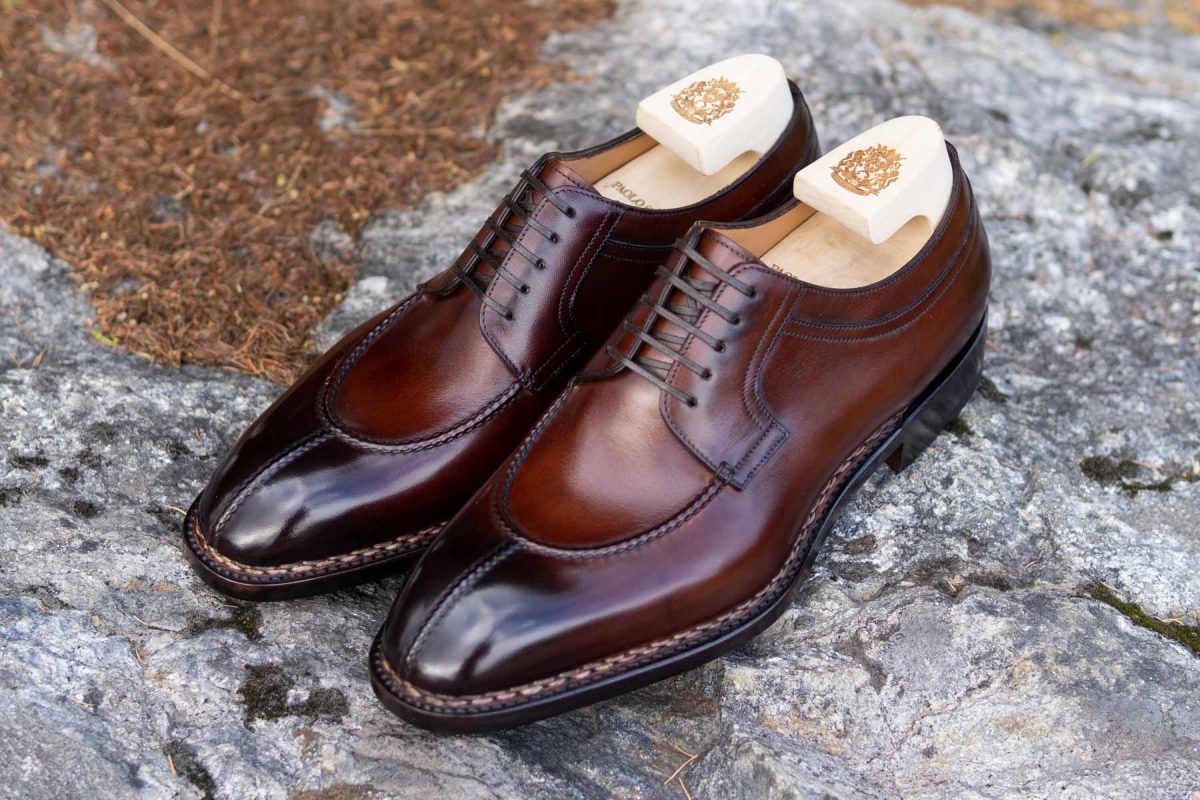


Skilled, high end shoemakers make these stitches by hand using a boar’s bristle.
Origin is unclear, but if you need to read more about this Jesper of Shoegazing has an excellent article (Link Here).
I believe that the more you explore dress shoes, the more you will grow to appreciate a Split-Toe Derby.
The Edward Green Dover is an iconic one, but my favorites are from Paolo Scafora and the Antonio Meccariello Centurion.
2.2.5 Apron Derby
Wait, didn’t we talk about this?
That’s right however you might notice that the word “Split” is missing.
It’s because this type of Derby retains the apron on the front however there is no split.
Here is an example from Italian Paolo Scafora.



2.2.6 2/3 Eyelet Derby
While most of the derbies above will have 5 eyelets there are some with fewer.
To be fair, I should really name this category “The Arca Derby“.
It would be an homage to creator Pierre Corthay whose grandfather taught him to use the stars as a compass in the sea.



Specifically, the Arca is a Plain-Toe Derby with 2 eyelets which spawned many copies.
However you can now find many versions with 3 eyelets and sometimes as little as 1.
I find them appealing casual models for the man that has an established wardrobe, but they are difficult commercially.
2.2.7 V-Front Derby
I debated talking about this in the previous section but I feel it deserves its own mention.
A V-Front Derby is what I call a 2/3 Eyelet Derby where the quarters create a sharp “V” pointing towards the front of the shoe.
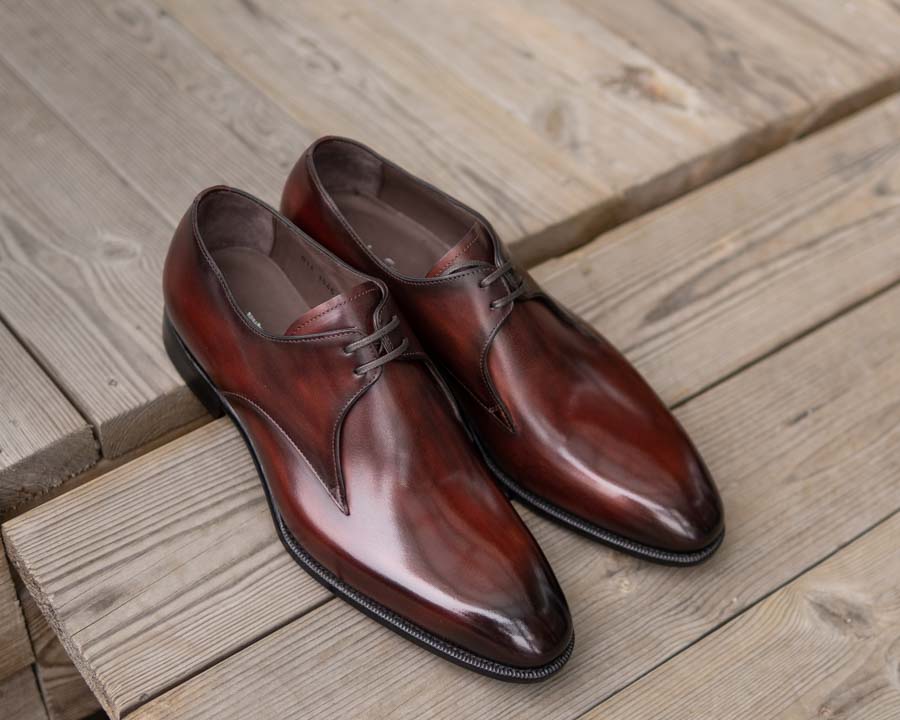


I am unsure about the origins or history, however it can look gorgeous.
My favorites come from Carlos Santos.
2.2.8 Bucks
I am thankful the community for pointing out styles I am unfamiliar with.
One of them is the White Buck Derby (or “Dirty Buck in Brown). There is nothing special about it other than the details of the make up.
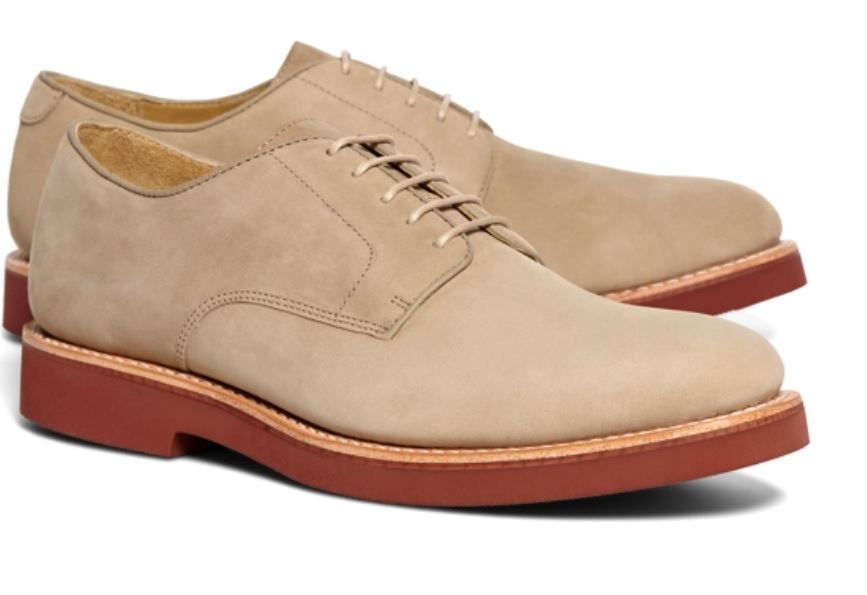


It’s a Derby in White (or Off-White) Nubuck or Suede leather and often comes with a red rubber sole.
Not sure who wears this these days, but I suppose it can be a casual shoe for the summer.
2.3 Monk Straps
Monk Straps are possibly my favorite types of dress shoes.
In fact, they are the reason I quit my job to begin my own business at The Noble Shoe.
They are a hybrid shoe combining the look of a derby and feel of a slipper. Well, not exactly but that’s how I feel when I wear them.
Their distinct feature is the presence of a strap with a buckle that runs across your instep and fastens them.
What fascinates me is that Monk Straps have such a rich history that dates back to the Middle Ages (1000-1500 AD).
Usually they will have a Cap-Toe or even Plain-Toe front but in some cases broguing or a wingtip design.
An incredibly versatile type of dress shoe that many say sit between a Derby and an Oxford in formality.
Honestly, in my opinion it goes well with everything and you should get one.
Tip: You can read more about the History of Monk Straps at Misiu Academy (Click Here).
2.3.1 Single Monk Straps
The more I grow up, the more I appreciate a good Single Monk Strap.
Quite an underrated style since it’s double strap “brother” is more popular.
A Single Monk Strap has of course just one strap and is very popular as a Plain-Toe. You can find it with a Cap-Toe or broguing details however a plain, clean Single Monk can be stunning.



It looks exceptional with most outfits and amazing with a tasteful soft square toe.
2.3.2 Double Monk Straps
Ah, the shoes style that stole my heart from the beginning.
Double Monk Straps have 2 straps on the buckle and is one of the most versatile styles out there for the modern man.
They were extremely popular during the last decade but the interest in Monk Straps waned a bit recently. Which means that now it’s the time to own one!



I prefer them with a Cap-Toe and in some cases a Suede buckle can look great as well.
Really easy to put on and off and will look at home with either jeans or a suit.
2.3.3 Triple Monk Straps
I cannot believe I have to type this section, but I guess this variation does exist.
Triple Monk Straps have a third strap and look ridiculous for a lack of better word.
There is simply not enough space between the straps and everything clutters and looks aesthetically displeasing.
A design as flamboyant as the monk strap does not need an even busier appearance.
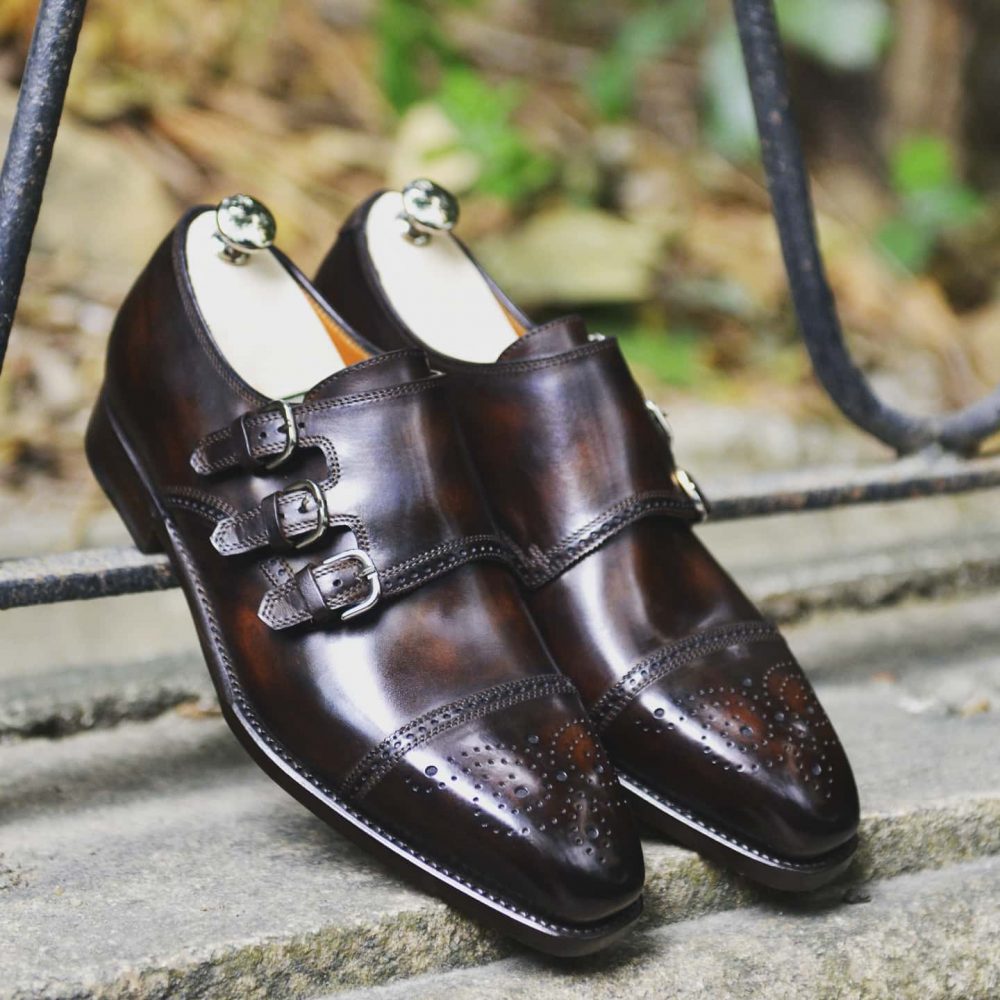


There are no respectable higher quality shoemakers that make this and if they do I hope they sit down and reflect. Yes, even the Bontoni ones.
It looks hideous and the fashion police will come for you. Avoid at all costs or you get no cookies tomorrow.
2.3.4 Quadruple Monk Straps
I think I feel physically sick.
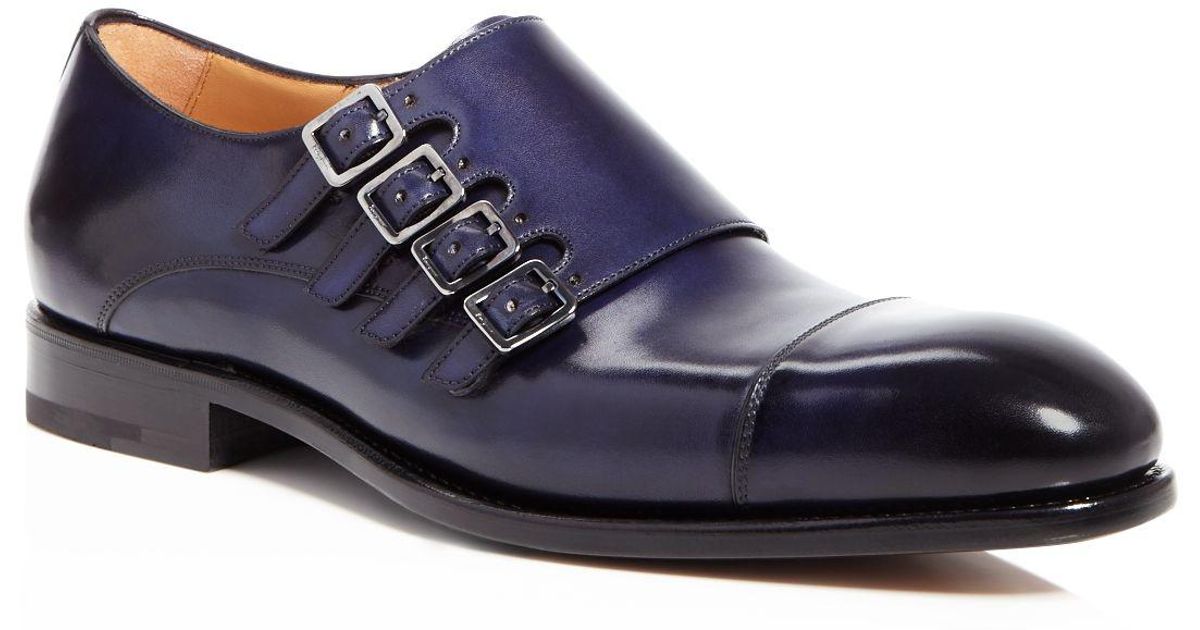


2.3.5 Monk Boots
If you take a monk shoe and turn it into a boot, you get a…..Monk Boot.
I know right, you are mind-blown. Regardless, you can find some pretty decent versions of Double Monk Boots lying around but there’s often something missing.
On the contrary, this is the only time where a Triple Monk Strap can work.



The pioneer of this style is French Septieme Largeur and their Tobar model which is excellent and proportionally perfect.
Versions with a single buckle do exist but it is more of a decorative element than a style.
Tip: Read my Review on Septieme Largeur (Click Here) and the Interview with their Owner (Click Here).
2.4 Brogues
Brogues are such an interesting category of their own.
I think it’s because of the fact that a Brogue is not really a “Shoe” by itself, rather than an element that defines a design.
It can be an Oxford, Derby, Loafer, Chelsea boot or regular boot.
Broguing refers to the perforations (or simply holes) in the leather with serrated edges along the stitching. You can call that pinking.
The original Brogue shoes originated from Ireland and had real holes, supposedly to drain the water out of your foot when in a wet terrains.
Today’s shoes have decorative broguing details that have leather underneath.
The patterns and quantity of the broguing define the naming behind each model.
Generally, shoes with broguing are less formal than their plain counterparts.
2.4.1 Quarter Brogues
A Quarter Brogue is the most discreet type of Brogue Shoe.
These types of dress shoes have a punched Cap-Toe with perforations and a serrated seam and nothing else.
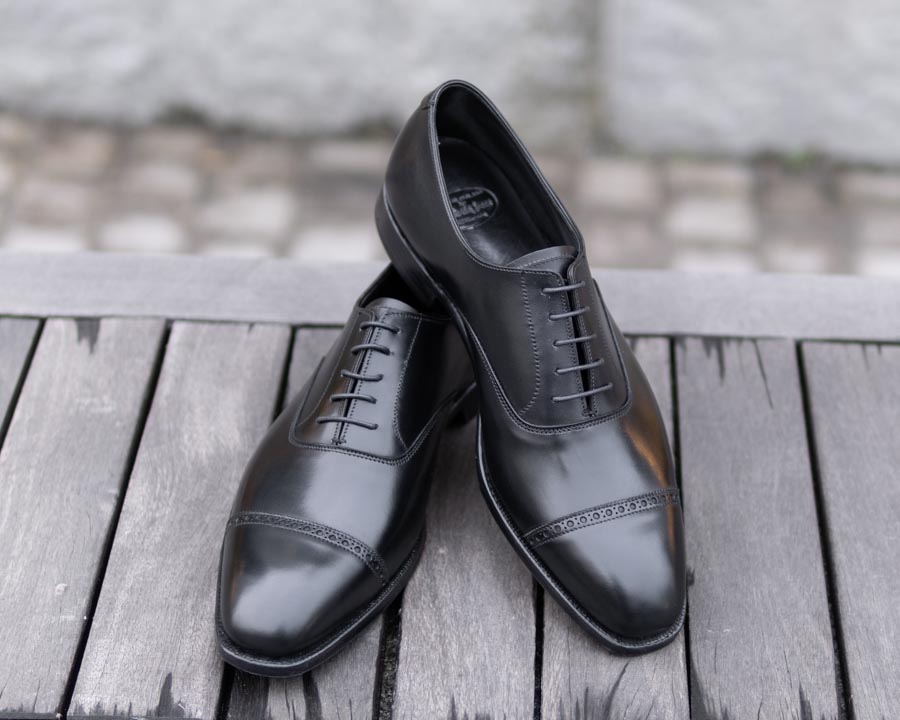


It looks excellent in black shoes in my opinion.
2.4.2 Semi-Brogues
Also known as a “Half-Brogue”, the Semi-Brogue is the next step up from Quarter Brogues.
They future the same perforated Cap-Toe but also add a medallion on the toe area, as well as on the edges and sides around the lacing area.
You could say that they are the middle option between a Full and Quarter Brogue, hence the term Half.



John Lobb was once again the pioneer behind this design, trying to refresh discretely a classic model such as the regular Cap-Toe.
An Adelaide Oxford resembles the Semi-Brogue in design, though the medallion is not necessary and the styling differs around the lacing area.
2.4.3 Full Brogues (Wingtips)
The most flamboyant and bold types of Brogue Shoes are the Full Brogues, or Wingtips as I like to call them.
They have broguing around the lacing, sides, quarters and toe of the shoe and sport a medallion toe.
What makes them special though is the interesting W (or M) toe pattern when you look at them from a bird’s eye view.



Broguing from all three major parts of the shoes (back, lacing, front) converge towards the middle part of the shoe (around your ball area).
This is quite a busy, casual style and a British classic. Often combined with a chunkier welt and outsoles or scotch-grain leather for a more country look.
Tricker’s, Grenson and Loake are some of the companies making these country shoes, however a wingtip can be more refined.
You will predominately Full Brogue Oxfords, Derbies and Boots.
Remark: I often see the term Shortwing to describe these, but I am not sure if there are actual differences.
2.4.4 Longwing Brogues
Longwings are yet another variation of Wingtips although in a Derby format.
This time around, the seams of the W at the front follow the shoe horizontally along the sides in a straight line.



Observe the picture and notice the seam going all the way to the back parallel to the sole.
These types of dress shoes seem to be more popular in the States.
Tip: Actually, all Longwings are technically Bluchers, but saying Derby is fine.
2.4.5 Wing-Toe
The most unusual of the Brogues is what I call the “Wing-Toe“.
As far as I know it has no official name and that’s the one I coined when I first saw it.
It is an oxford with a sort of Wingtip design, however it also has a Cap-Toe.



As a result, the “W” moves further up the shoe right underneath the lacing system.
Very interesting to say the least and a rather controversial style that looks much better in person rather than in photos.
The only ones I saw was from Carlos Santos and a similar model from Antonio Meccariello.
2.4.6 Ghillie Brogues
This is a style I am not too familiar with so I just did some quick research.
A Ghillie Brogue is a traditional Scottish shoe with a Wingtip design but the main difference is that they have no tongue.
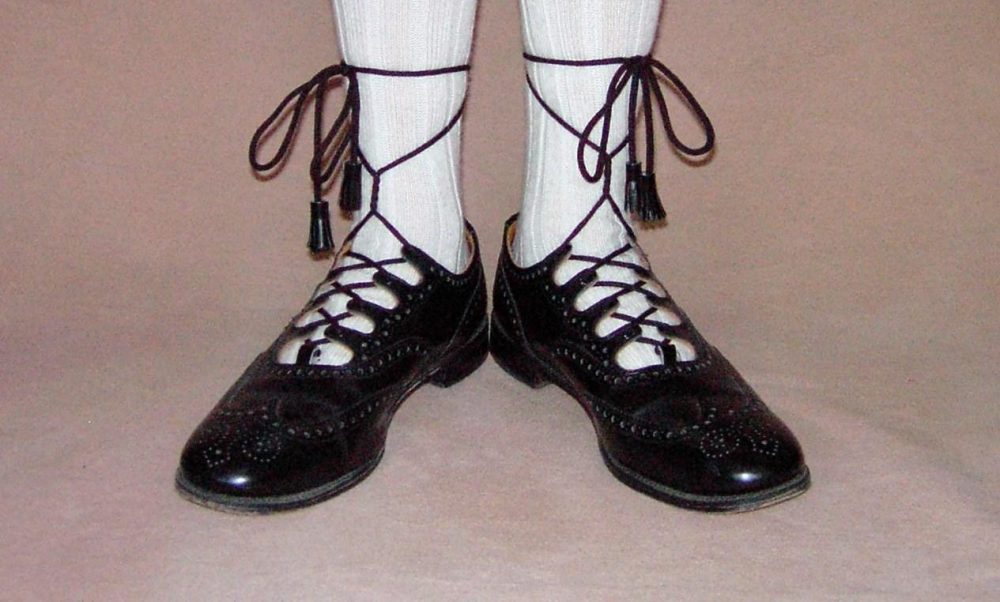


The laces are quite long and you wrap them around your calf.
It looks a bit uncomfortable but then again, this is a traditional shoe for rarer occasions.
2.4.7 Spectators
Spectators are a very interesting type of dress shoes but also one that I find hard to visualize on my feet.
An Oxford with a wingtip pattern but a distinctive bi-color configuration which is usually black/white or brown/white.
If I recall right, it was John Lobb (the legendary shoemaker) that designed this style for cricket in 1868.



Very interestingly, people thought it was a tasteless shoe and often associated with adultery and pick-up artists.
There are many variations these days and some even use cloth material but very few capture my interest.
2.5 Austerity Brogues
Welcome to my favorite type of dress shoes and brogue, even though it isn’t one!
The Austerity Brogue is essentially a Wingtip in design however it has no real broguing (perforations).
Instead, the Austerity Brogue instead has a seam and stitching that mimics the Wingtip.
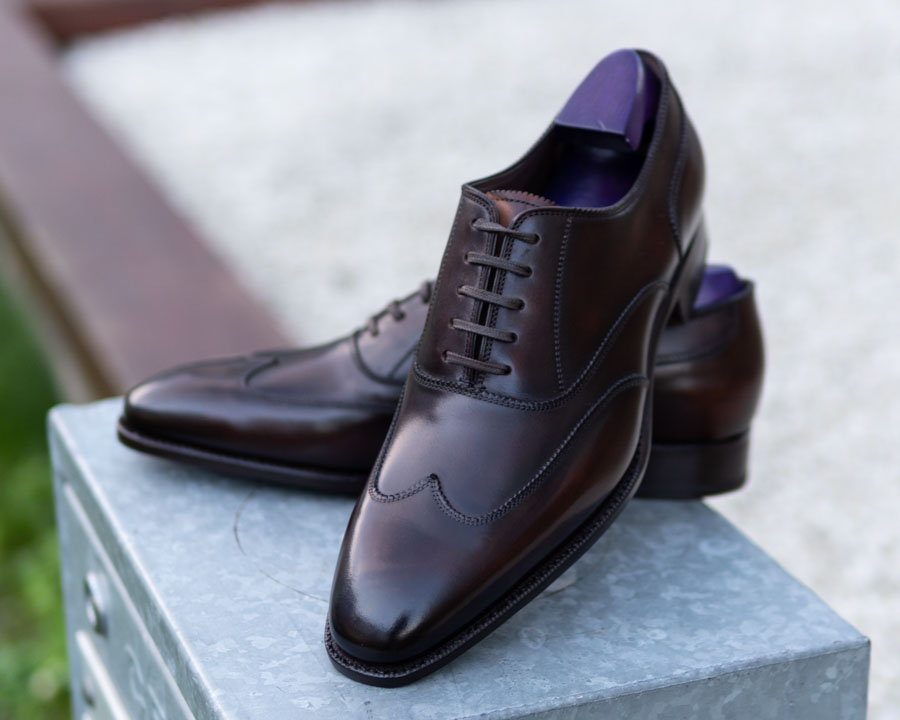


You can find this in multiple styles, including Oxfords, Derbies and even Boots. I couldn’t find a clear answer about the history other than this explanation from another blog:
“During the Second World War, when tight restrictions were placed on leather usage, English shoemakers offered full brogues without broguing, called “austerity brogues. Their distinctively sleek lines ensured their survival beyond the war, and they remain popular with dandies as an alternative to the plain cap toe.”
I suppose you can choose to believe this or not, however it is a beautiful style when done right.
2.6 Chelsea Boots
Chelsea Boots are a stylish wardrobe essential.
It is an Ankle Boot with elastic side panels (gussets or gore) that allow an easy entry for the foot.
There is a reason for that as Chelsea Boots have a rich history dating back to the 19th Century.
Joseph Sparkes Hall (who we mentioned before!) designed these for Queen Victoria to create a stylish shoe that would be easy to pull on and off.
It was the Beatles that made this so popular and even the Stormtroopers in the old Star Wars films used them.



Chelsea Boots in my opinion look best in their classic Plain-Toe, though there are a few versions with broguing or features I don’t really like.
Those usually involve toying with the shape of the elastic side which today has traditionally a U shape.
In my opinion, a pair of Chelsea Boots in Black, Brown Calf (or Suede) should be in every man’s wardrobe.
Tip: Some companies make Wholecut Chelsea Boots with no side seam under the elastic panel.
2.6.1 Low-Cut Chelseas
Debatable if this is a style at all, but I suppose you can find low-cut versions of Chelsea Boots.
Some seem to use the name Romeo Boots but the samples I found on the internet look ugly.



They are just Chelsea Boots with a shorter shaft and it looks proportionally difficult to combine with the elastic sides.
Crockett & Jones and Cheaney are some of the welted brands that offer this style.
2.7 Chukka Boots
Yet another wardrobe staple is the evergreen Chukka Boot.
A shorter ankle boot with minimal stitching and only two side panels stitched on the vamp which form the lacing.
It is a style you will mostly encounter with a Plain-Toe and 2-3 Eyelets. In rarer occasions you can find one with broguing, a Cap-Toe or even an apron.
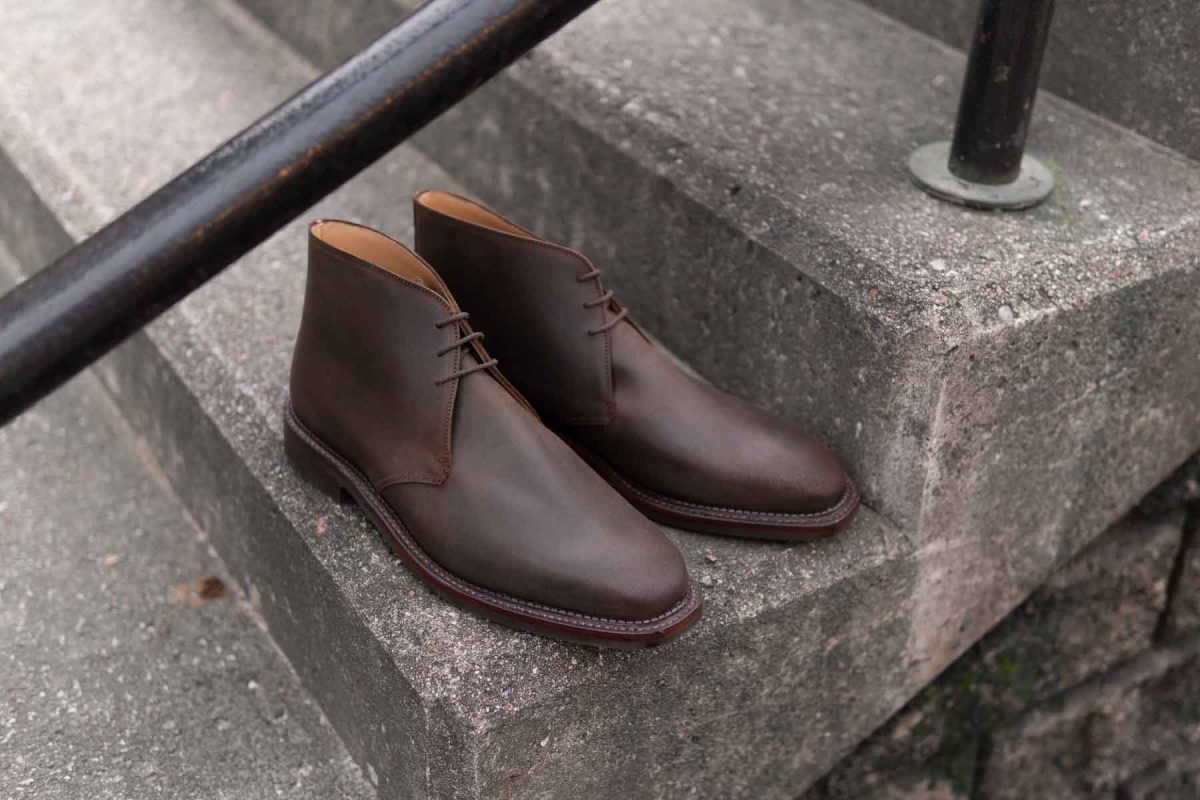


The Style became popular after the release of the original Clarks Desert Boots and is phenomenal in suede or calf.
While a more casual shoe, it is perfect for everyday outfits and a go-to if you never wear suits.
2.7.1 Desert Boots
Now, there is really no difference in the raw aesthetics between a Desert Boot and a Chukka Boot.
The differences are more stylistic and (usually) have a pre-defined design.



Typically, Desert Boots had suede uppers and a crepe sole and come with a rich military history and inspiration.
Tip: You can read more about Chukkas and Desert Boots in my “Best Chukka Boots” Guide (Click Here)!
2.8 Jodhpur Boots
Jodhpurs are a bit of a stranger type of Ankle Boots that I don’t see often in the wild.
In many ways they resemble a Chelsea Boot however instead of the elastic sides, you use a strap that goes all around the shaft to fasten the shoe.



They are yet another type of dress shoe that has a fantastic history and originate from India in the 20’s and the game of Polo.
Very interestingly, if someone say’s just “Jodhpur” he can talk about the riding trousers instead. In many ways the boots seemed to be a companion for these trousers during horse riding sessions.
Nice and clean with a Plain-Toe, Jodhpur Boots don’t leave much room for tinkering. However you can find nice variations with more straps and custom versions with straps from suede or exotic materials.
If you like to dress casually, brown and tan colors are classics.
Tip: Read my Review of the Septieme Largeur Jodhpurs (Click Here)!
2.9 Loafers
I must admit, I don’t like loafers so much. At least not on my feet.
One cannot deny however that this type of slip-on shoe is comfortable, easy to use and a popular Summer choice.
Depending on the details on their apron, loafers get a different name but in essence they are the same.
Nowadays there are a lot of wider variations so I will try my best to cover them.
2.9.1 Penny Loafers
The Penny is a type of Loafer with a broader strap that runs all the way over your instep.
Legend says it was Norwegians who created this style.
But it was when teens began hiding coins in the straps for good luck or emergency phone calls that it got the name Penny Loafer.



The most usual design includes a moc/apron pattern on the front but there are some rare models with a split-toe.
Penny Loafers are probably the most popular Loafers and the “casualization” of classic menswear means you can often wear them with a suit.
Tom Ford said don’t do business with a man in Loafers though!
Justin Fitzpatrick has a version called the “Butterfly” Loafer due to the way the strap twists and folds
2.9.2 Tassel Loafers
A Tassel Loafer is my favorite kind of Loafer and rather elegant.
Instead of a strap, it has a strip of leather on the top of the vamp and two leather tassels with fringe edges.



It was Alden and Brook Brothers that collaborated in 1957 to create the first Tassel Loafers as a commission for actor Paul Lukas.
2.9.3 String Loafers
String Loafers are exactly the same as Tassel Loafers with one main difference.
Instead of the tassels hanging at the top of the vamp, you get instead think strips of leather.



These look a bit like shoelaces, or “strings”.
2.9.4 Kiltie Loafers
I need to take a deep breath when writing about Kilties.
Take a pair of Tassel Loafers and put an extra piece of fringed leather on the vamp and you get a Kiltie Loafer.



Of course you can find Penny variations but just buy a broom instead.



2.9.5 Horsebit Loafers
I have strong opinions about designer shoes, however no one can deny Gucci created the original Horsebit Loafer.
In 1953 Aldo Gucci replaced the strap on the vamp with a golden bar that resembles a horse’s snaffle bit. Thus the name Horsebit.



These days the bar can take various shapes and forms but the original still goes strong today.
It will still cost you a pretty penny though (pun intended).
2.9.6 Belgian Loafers
And here we have another style of Loafers with a unique name and history.
Belgian Loafers come from….America. More specifically around the 60’s from a company called “Belgian Shoes”.



However, the origin of the shoe fittingly does come from Belgium and its shoemaking hub: Izegem.
The style has a long apron with no details or a decorative tiny bow-tie/tassel.
I like them in Suede and Berwick makes entry level affordable options.
Tip: Read more about their history here.
2.9.7 Monk Strap Loafers
What do you get when you mix a double monk strap and a loafer?
You get this unholy mother of Frankenstein.
This is a shoe that should not exist because of its ridiculous proportions and design.
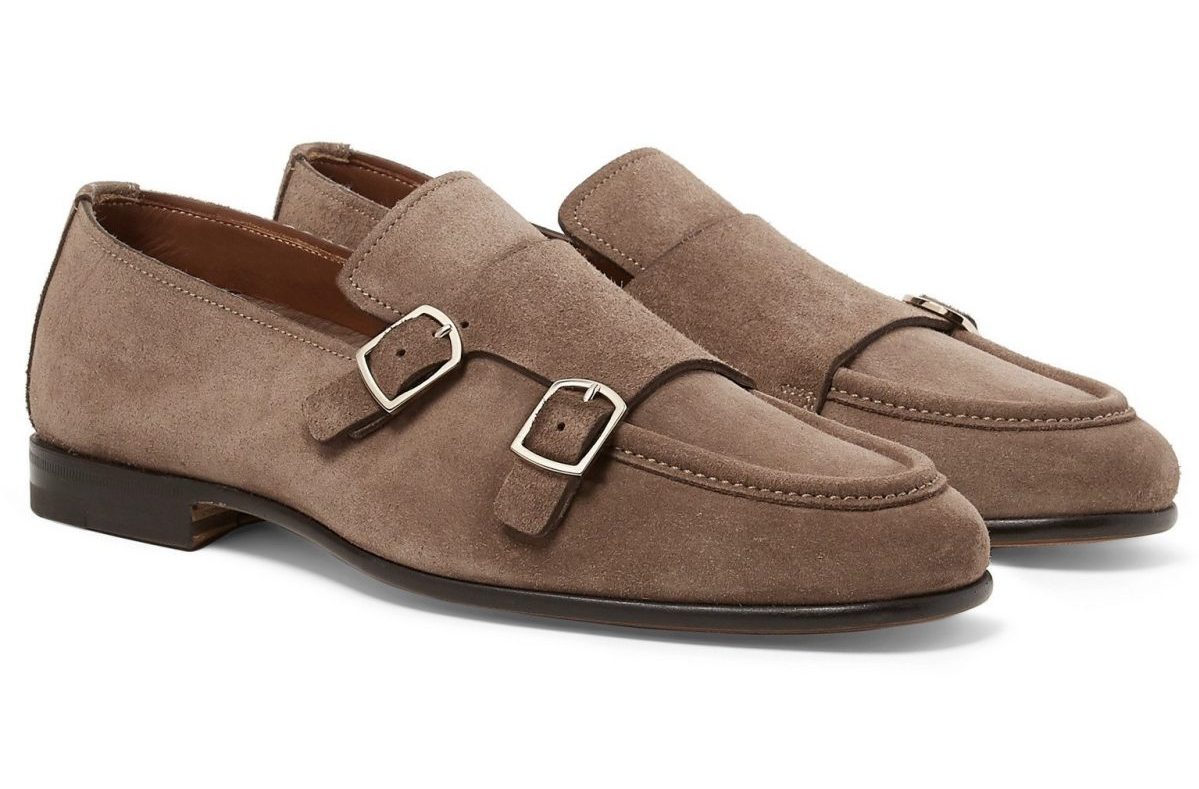


The strap covers most of the vamp and leaves a tiny space for the toe area. The only thing this achieves is to make the shoes look shorter and your feet more feminine.
I think this became popular due to the countless clones of Bespoke Factory that offer this default style.
To take your mind off these abominations, here’s a picture of a cute Alpaca.



2.10 Boots (Broader Category)
Boots are rather self-explanatory and need no introduction.
However as you might notice, we already covered a few special styles in the previous sections.
Here however, we are going to discuss a lot of the different variations of (mostly) casual boots.
The lines are blurred heavily between a few of them so don’t be alarmed if you think a Service and Work Boot are exactly the same.
If you have knowledge and good suggestions, I would more than welcome your contributions via email or comments!
2.10.1 Wholecut Boots
Starting things off with a really dressy type of boot that is essentially a wholecut.
Ankle Boots from a single piece of leather and a Plain-Toe and extra details the designer might want such as a medallion.
They look very dressy and they are quite rare but revered among enthusiasts.
Carmina makes some good entry level ones but the Antonio Meccariello Cataline Seamless Wholecut Boot is true art.



Breathtaking.
2.10.2 Balmoral Boots
Remember the Balmoral Oxford?
We briefly mentioned it takes inspiration from the classic Balmoral Boots and here they are!
A Lace-up Ankle Boot with an Oxford-type lacing (closed) and has a distinctive seam that runs parallel to the sole around the sides, starting at the bottom of the lacing.
These days you will mostly see them with 8-9 Eyelets and quite often with a punched Cap-Toe or a little broguing.



This is an excellent dressy boot with a rare chance of a bi-material/bi-color set up.
Whether in pure black or with suede uppers, a Balmoral is the connoisseur’s weapon of choice.
2.10.3 Jumper Boots
A Jumper Boot is a versatile, casual everyday boot.
Essentially a higher ankle Lace-up Derby Boot with a straight Cap-Toe, 4 eyelets and 4 speed hooks.
Speed hooks are those tiny hooks that allow for quick lacing diagonally.



Very interestingly the have a feature I call “Hockey Stick” because the shape of the facing reminds me of an actual hockey stick.
This type of boot looks great in suede or calf leather with a dainite or chunkier commando sole and a storm welt.
2.10.4 Field Boots
Field Boots have a military background if you ponder at the name closely.
Field Grade Officers wore them in the cavalry but the “proper” field boots are knee-high.
In a more modern set up they are slightly higher ankle Lace-up Boots with open lacing (Derby) and the same amount of eyelets and speed hooks as the Jumper Boot.
The main difference lies in the shape that the seam/stitching creates with a distinctive wide “V” along the quarters.
There is only one iconic boot that made this style popular and that is the Edward Green Galway.
A boot perfect in many remarks and with countless possible bi-material/bi-color combinations.
Many companies make excellent copies including Carlos Santos, Vass, Antonio Meccariello and more. However the original Galway will always retain its prestige and scepter.



They also cost an arm and a leg!
2.10.5 Monkey Boots
Monkey Boots are ugly. Beautifully ugly for some.
Another type of Lace-up Derby Boot with a tractor sole and Plain-Toe. Here however the facing and the laces extend so far down the vamp that are almost at the toe.
Very interestingly, there was a rumor that they began in the Czech army during WWII. However that is historically inaccurate as Czechoslovakia was already under German control before the war.
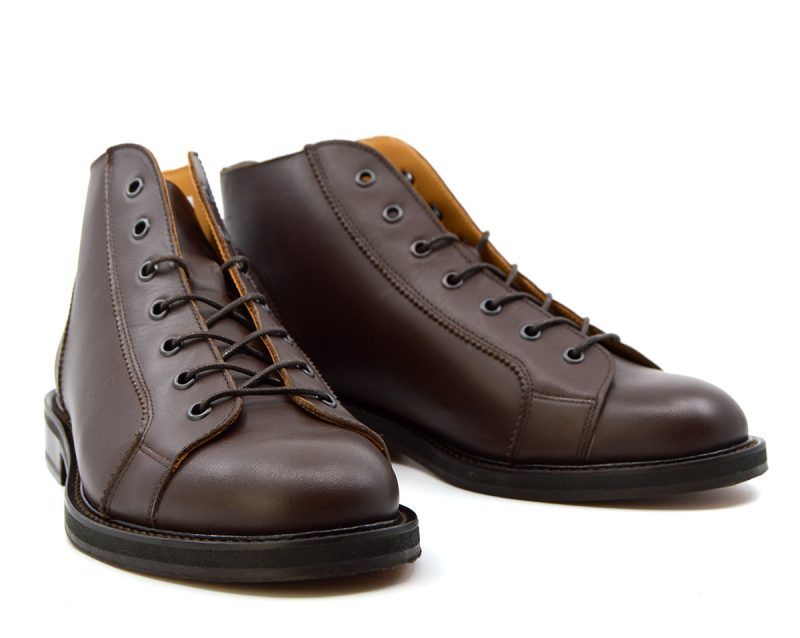


Love them or hate them, they have a rich history and their own style.
Tip: Read this excellent article on Monkey Boots (Link).
2.10.6 Service Boots
Back at World War II. See the pattern?
Welted, ankle height derby boots with a plain toe and a hardwearing sole.



The most famous type of Service Boot in the USA seems to be Viberg, though there are great boots coming out of Asia at the moment.
Thanks to your contribution I added the correct style of Service Boots. It has extra arched stitching on the back of the quarters otherwise it is just a Derby Boot.
2.10.7 Moc-Toes
When one say’s Moc-Toe there is only one brand that springs into mind.
That is of course the iconic and ever popular Redwing Classic 875/877 Moc-Toe.
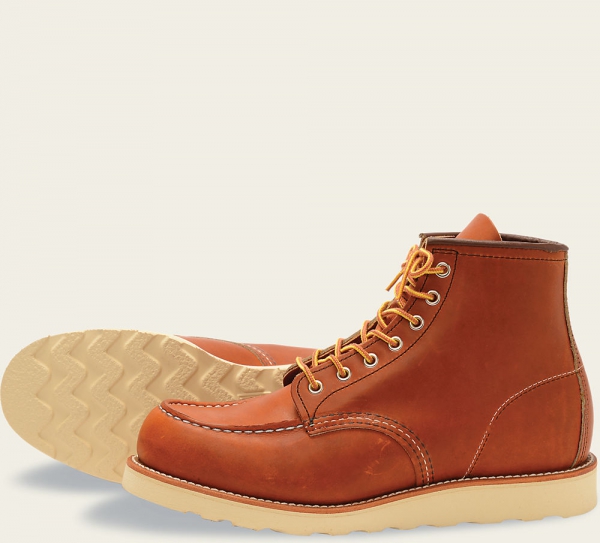


Introduced in the 50’s by American Redwing, it still remains one of the most popular type of boots judging from the discussions on Reddit.
They still retain the open lacing Derby system but at the front have an apron-like moc area. It reminds me of the classic moccasins but in a boot format.
Whether you get them in black or their classic copper red, you will wear them into their ground with their uniform white foamy sole. I think this is still a tractor sole right?
Virtually unchanged in the last 70 years, this is a great casual work shoe.
2.10.8 Steel-Toe Boots
Without complicating things, Steel-Toe Boots are work boots with a reinforced steel toe.
Their main purpose is to protect the wearer from potential injuries such as falling heavy objects.
Many also have other qualities such as being nail proof and resistant to electricity.
2.10.9 Button Boots
More stories from the Victorian era! This time with the Button Boots, or “Victorian Style Boot”.
These are old school high boots with button instead of lacing and one of Queen Victoria’s favorites. She sure had a strong impact in modern shoemaking.
Apart from the button functionality the rest of the design is almost identical to the Balmoral Boot.
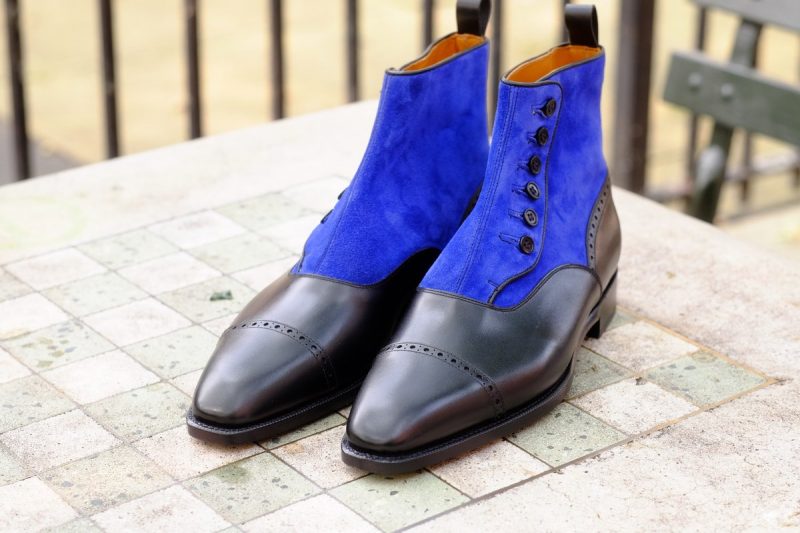


The popularity of the Button Boot dropped in the beginning of the 20th Century and nowadays is a very acquired taste for few.
Buttoning them is a laborious and slow process, even though there are certain hooks that allow for quicker fastening.
Quite a few companies still produce limited special models but it is J.Fitzpatrick that has a whole line up of them in bright bi-material make ups.
Personally I never understood the appeal and is not a style that interests me.
2.10.10 Combat Boots
Probably the most convoluted, unclear category of Boots is Combat Boots.
I won’t talk much about these, but the core is a military boot issued to soldiers.



I was in the special forces and they are usually heavy duty. The Greek Army supplied us with garbage by the way.
Then you have Jump Boots for the Paratroopers with extended lacing all the way up your calf and a rigid toe. Due to the popularity of the maker during WW II, some even call them Corcorans.
To be fair, I can assume that Jumper Boots could be a modern version of these. Anyone know more?
2.10.11 Engineer Boots
A very rare breed of boots with more popularity in the USA.
Engineer boots are essentially Jodhpur Boots with a higher shaft which is at least calf high.
Instead of the Jodhpur’s single strap at the bottom, Engineer Boots have an extra one at the top.



Actually I am not sure why they call them “Engineers” since they have a military riding background.
During the more rebellious teen times post WWII these were the choice of motorcycling enthusiasts.
Nowadays, good welted Engineer Boots are rare but still made by classic companies like Frye.
2.10.13 Harness Boots
Closely related to Engineer Boots, Harness Boots are another prime example of motorcyclist fashion.
Predominantly black with heavy duty leather. The difference is that the strap that goes around the boot is decorative and joined by a metal ring on each side.



As aforementioned, the strap is decorative and serves no purpose.
Unfortunately, I don’t know much more about them.
2.10.14 Zipper Boots
I suppose this is a category of its own.
Most boots can have a Zipper in the inner part and that’s everything you need to know.
Whether it is Triple Monk Boots or Plain Zipper Boots if you add a Zipper it becomes something new.



Increasing in popularity due to their ease of use, even I have one.
2.10.15 Tankers
Here things get really crazy.
Tanker Boots are just plain military boots that tank personnel wears.
They have straps that wrap around the shaft, giving an advantage compared to traditional laces which can come undone during combat.
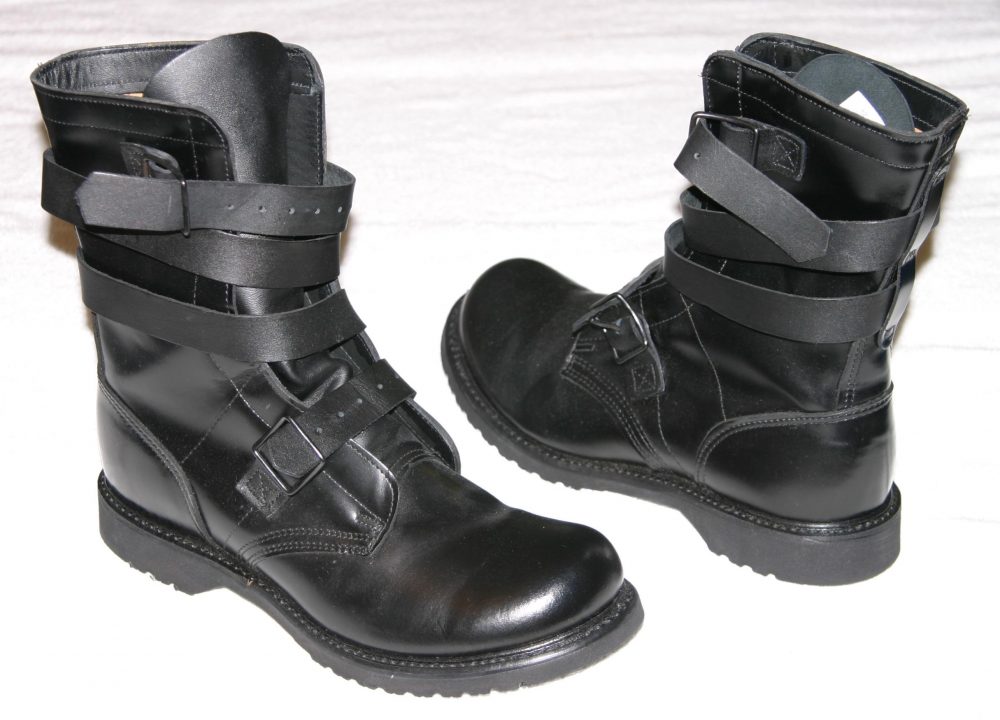


Of course they have other safety features such as a steel toe, comfortable wide last for good blood circulation and rather waterproof.
Sounds pretty straightforward but we also have the classic Alden “Tanker”.
A Derby Boot with a handstitched apron and a split-toe. Very popular in Shell Cordovan and sometimes with contrasting stitching.



A non split-toe similar version from Alden is the Indy. Rumor has it that it was a different model worn by Harrison Ford during the Indiana Jones movies and Alden later rebranded it.
To be fair, all these have a strong sturdy build and you can refer them as “tanks”.
2.10.16 Hiking Boots
I am not sure what to think of exactly when I say Hiking Boots.
On the one hand, you have the classic, bulky durable ankle boots with EVA soles and practically waterproof.
If you like hiking or the outdoors, these are probably in your closet.
On the other hand however you have a more modern variation which is stylish and I like very much.
More for urban trekking and everyday use, modern Hikers can look pretty elegant.



If you can get one with shearling lining like I did, they are the perfect winter casual shoe.
2.10.17 Cowboy Boots
Another USA thing we never see in Europe, Cowboy Boots are self-explanatory.
I do see a lot of variations on Instagram regarding the toe area. Some seem to favor a round toe, but others a hideous, arching pointy toe. They are probably great at killing spiders in the corners.



Cowboy Boots come with a high shaft of about 8+ inches (that’s 20+ cm for us Europeans) and use various materials.
Gator Boots seem to be popular and I have seen some horrendous sea bass monstrosities.
2.11 Moccasins
Moccasins are a very unique type of dress shoes mainly due to the construction.
Well, they are not anywhere near “dress” but I want this guide to be as complete as possible.
They are essentially slippers but the interesting part is that they have a fully hand sewn construction right on the last. As you shape it around the last like a bag, you sew it by hand to create a very comfortable moccasin.
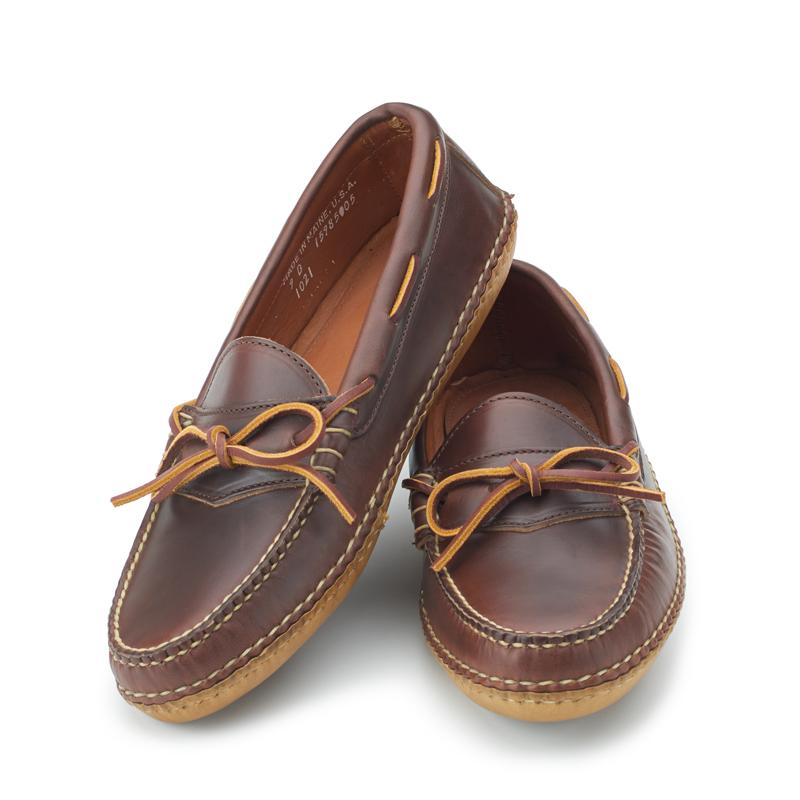


A way to tell this is to look underneath your own moccasins. In this method the material will be the same as the uppers.
2.11.1 Driving Moccasins
Commonly known as Driving Shoes, these are a type of moccasins that are lightweight and often have a rubber pebble outsole.
You get a star if you guessed that you use them for driving.
Tod’s make some of the most iconic Driving Shoes but my god are they expensive.
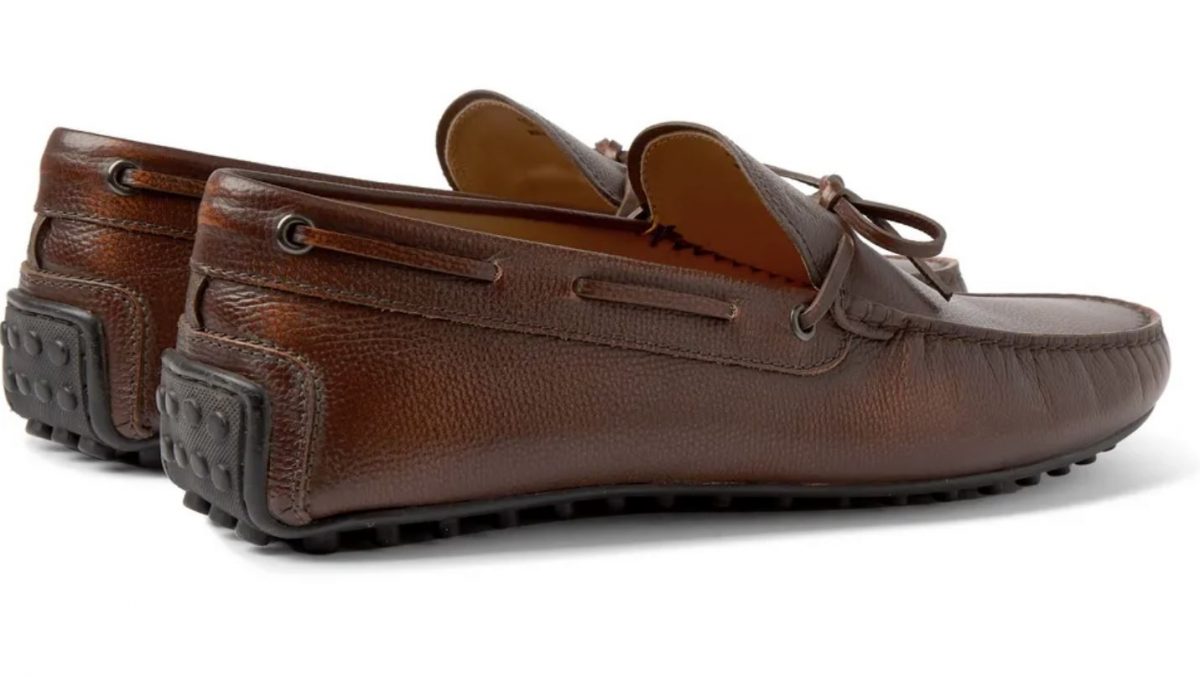


Tip: Read this excellent Guide by Heddels on the History of Moccasins.
2.12 Boat Shoes
Boat Shoes are the kind of shoes that my father used to wear.
A very casual, summery type of shoe that shares construction details with moccasins or even loafers.
Originally meant to be worn on the decks of ships (hence the name), Boat Shoes are rather minimalist with a large apron lookalike.
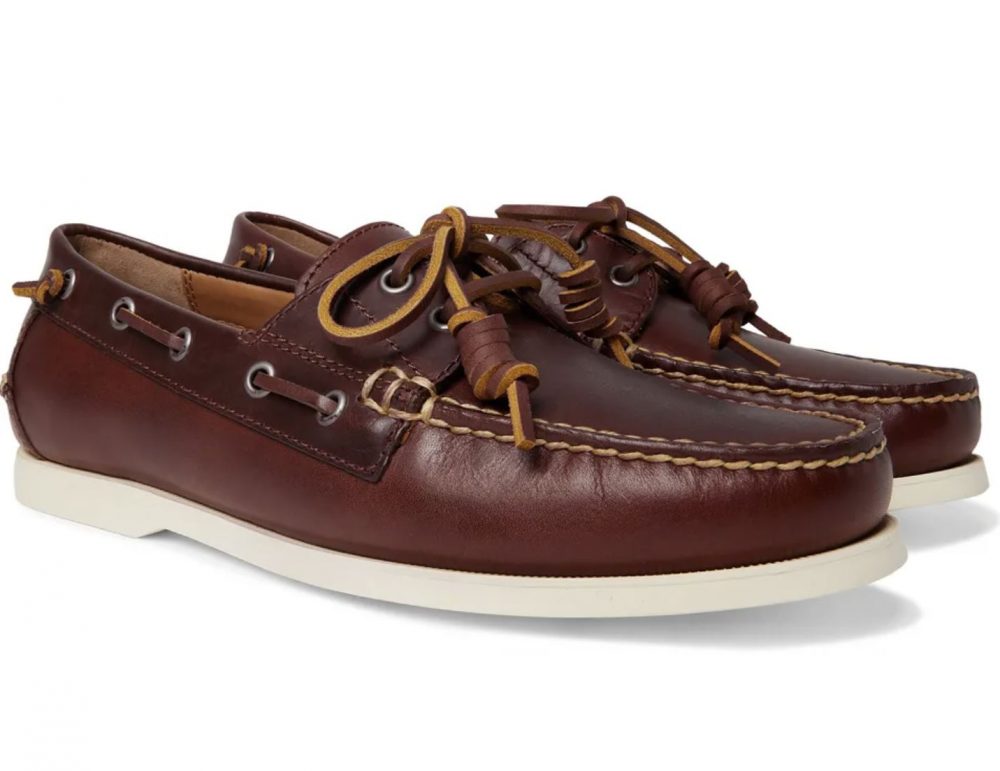


It thrives in warmer environments but I live in Sweden so I should shut my mouth and cry.
2.13 Special Models
2.13.1 Kilties
If there is one style of shoe that is enough to make me vomit, this is anything with a Kiltie.
A Kiltie is an extra piece of leather with fringed edges that for some twisted reason someone decided to sew on the vamp.
You can find it in Loafers, Derbies and even some Monkey Boots.



It’s one of the few styles I will never own or bother to try.
Now if you’ll excuse me, I have to go clean my throat with disinfectant.
Update: Despite my obvious disdain on the style and fun comments, many of you made valuable contributions. It seems that not all Kilties are replaceable and they actually used to serve a purpose. According to Nicks Boots, the purpose of a Kiltie was to protect the tongue from dirt, dust and debris.
2.13.2 Opera Pumps
Opera Pumps could possibly be under the Loafers category as they are a slip-on shoe.
However their formality and situational use calls for their own section. It’s one of the most formal shoes a man can wear.



Typically made in black patent leather or even velvet with a bow tie, one wears Opera Pumps as evening wear and Black Tie.
2.13.3 Patent Shoes
In continuation of the previous section we have Patent Shoes or Evening Shoes.
Patent Leather is a very glossy, reflective type of leather that you get from high polishing.



Design can slightly vary but for me Oxfords are the real Formal Patent Shoes.
Reserve them for Black Tie events.
3. Basic Shoe Terminology
And that was it! Before I wrap things up however, I will try to explain/sum up some basic shoe terminology:
- Uppers: The whole part of the “upper” part of the shoe without the sole
- Sole: A sole (or outsole) is the bottom part of a shoe. Made from leather or rubber and in direct contact with the ground
- Vamp: The front part of the uppers towards the toe area
- Quarters: The back part of the uppers which begins where the vamp ends
- Broguing: Perforations (holes) in the leather with serrated edges
- Medallion: Broguing in the toe in the shape of a medallion
- Cap-Toe: A seam that runs vertically from one side to the other on the toe of a shoe
- Plain-Toe: The whole vamp/toe area is clean without any stitching
- Reverse Stitching: When the stitching happens underneath the skin of the leather so only a bump is visible outside
- Welt: A leather (or rubber) strip on the top edge of the outsole that helps connect the uppers to the sole
- Fiddleback waist: When the waist is thicker in the middle and thins/arches towards the edges
- Beveled waist: In simple terms when the shape of the shoe narrows down towards the waist, creating a bevel
- Last: A three dimensional form of a human foot that you use to make a shoe
- Eyelets: The holes where your laces come through
- Throat: The small opening where you attach the tongue and lacing begins
- Tongue: The piece of material that sits underneath the laces
- Heel Block: The back bottom part of the outsole where your heel lifts from the ground
- Backseam: Stitching that begins at the bottom of your heel up to your achilles. Connects parts of the shoe together
- Toe Shapes: Chisel, Almond, Soft Square, Medium Round, Round Toe are just a few and describe the shape of the toe area
- Split-Toe: A seam on the front of a shoe which connects an apron to the toe
- Closed Channel Stitching: When the shoemaker cuts a channel in the leather sole to hide the stitching under a thin leather layer
- Kiltie: A fringed decorative piece of leather and the source of all evil
There are many more but maybe I should write a more detailed separate article on this?
4. Thoughts On Dress Shoe Formality
Last but not least, it is worth briefly discussing shoe formality and hierarchy.
We already live in an increasingly casual world where white/blue collar jobs are much rarer than before. At the time of writing, the Covid-19 pandemic further accentuated this with a strong shift towards casual and street style.
When you can wear jeans or sometimes shorts in your workplace, you can blur the lines of formality and it doesn’t matter if it’s oxford or loafer you wear.
In any case, you should follow some sort of etiquette or have a basic idea.
4.1 Hierarchy & Details
The most formal shoes a man can wear outside of Black Tie are Oxfords.
Then it becomes much more flexible, as Derbies, Jodhpurs, Chelsea Boots and Monk Straps are strong, versatile contenders for all types of outfits.
Chukkas, Loafers and most Boots are casual shoes and you would not wear them with a formal suit, however anything under goes.



The exception is Loafers which you can surely wear with suits, but I don’t like them. That’s my personal taste, don’t be angry over this!
When it comes to details, the less on a shoe, the more formal it is. A Quarter Brogue for example will be slightly less formal than a Classic Cap-Toe Oxford.
The leather can also dictate formality and appropriateness. Smooth calfskin is the most formal while any kind of textured leather such as scotchgrain is more casual.
Shell Cordovan is smooth (and amazing!) but is a little glossy and lustrous compared to calf.
Lastly, a leather sole is always going to be more formal than a rubber one, however I can hardly tell what sole the other person’s wearing in real life.
By that I mean comparing a simple Dainite sole and a leather version.
Some say that you should never wear Oxfords with jeans. You know the rules, you know what you like. If you enjoy how it looks on your feet just do it.
If you worry too much about it, then you let the wrong internet personas influence you.
Unless of course you decide to wear boat shoes with a navy suit, or hiking boots with shorts. Then you need help.
Types Of Dress Shoes Summary
As we reach the end of this pretty big “Types of Dress Shoes Guide” it is a good idea to sum things up a bit.
To begin with, there are tons of variations within the same categories and often quite unclear with subtle differences. An Oxford can be a Plain-Toe, but a Plain-Toe doesn’t have to be an Oxford.
Then you have countless leather options, multiple construction methods and use for each type of shoe.
Follow the basic rules of formality and find your personal style. As your taste evolves, you will see that you enjoy things you never did before.
So keep an open mind and if you liked this article (I hope you did, it took me 2 weeks to write) bookmark it, share it and don’t forget to Subscribe!
Questions or suggestions are super welcome in the comments section!
Thank you for reading,
Kostas Mandilaris,
Misiu Academy


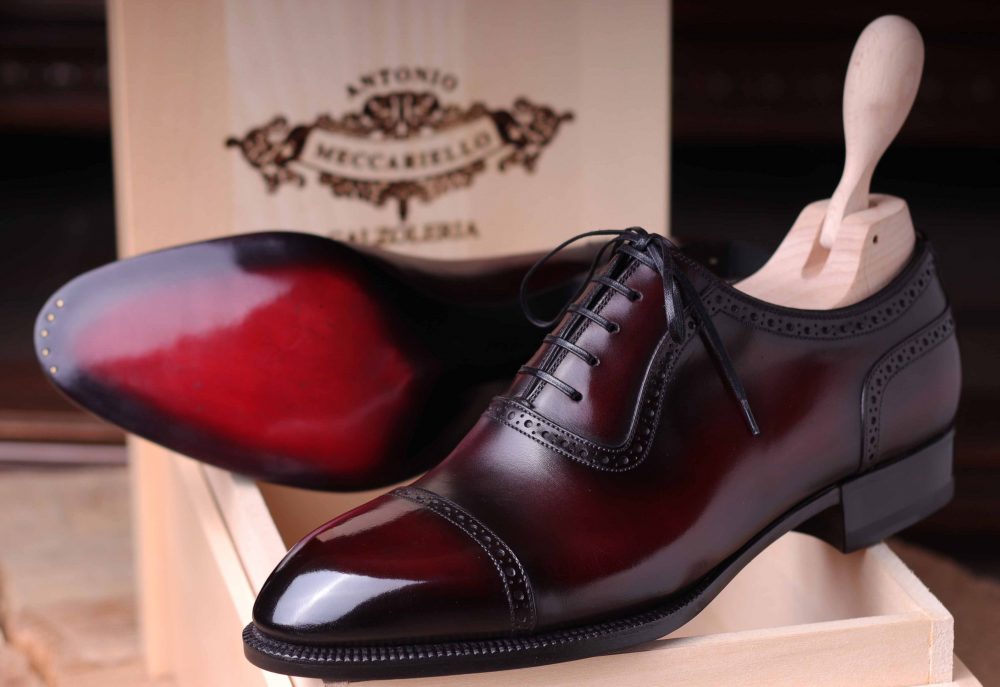
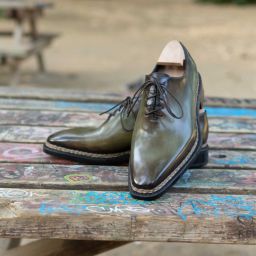




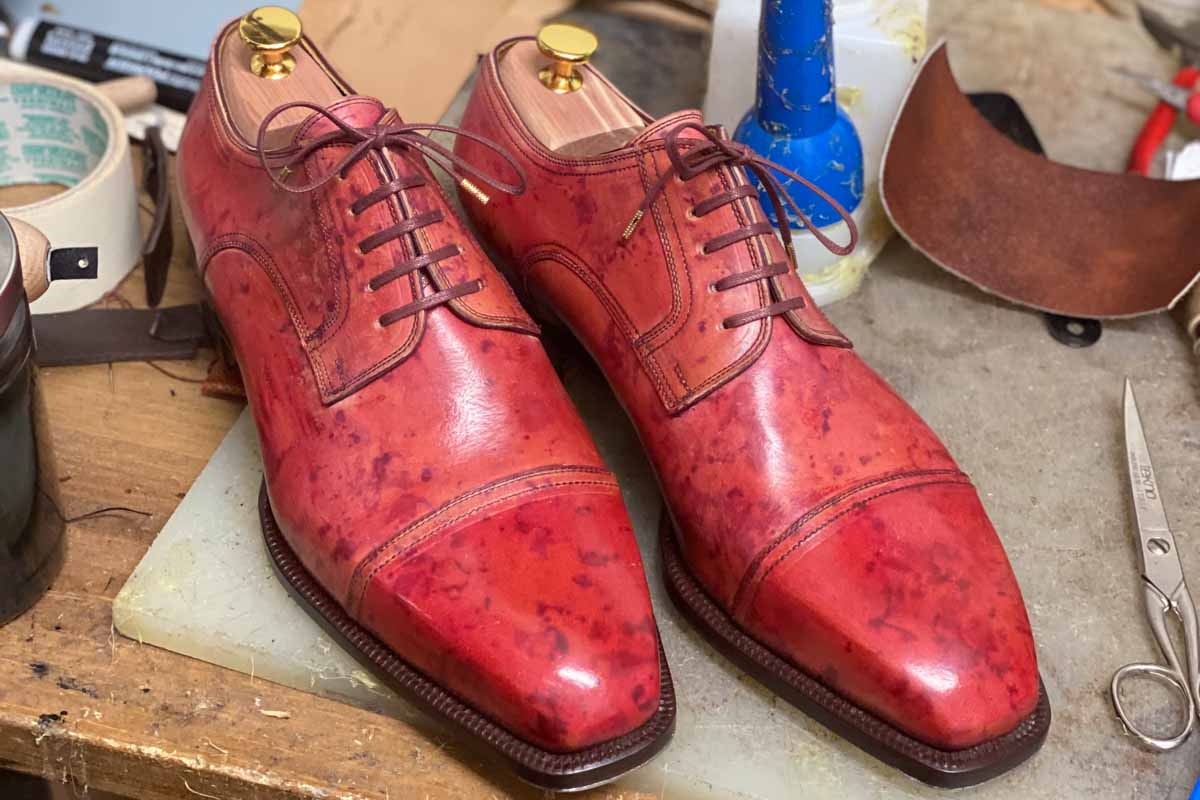

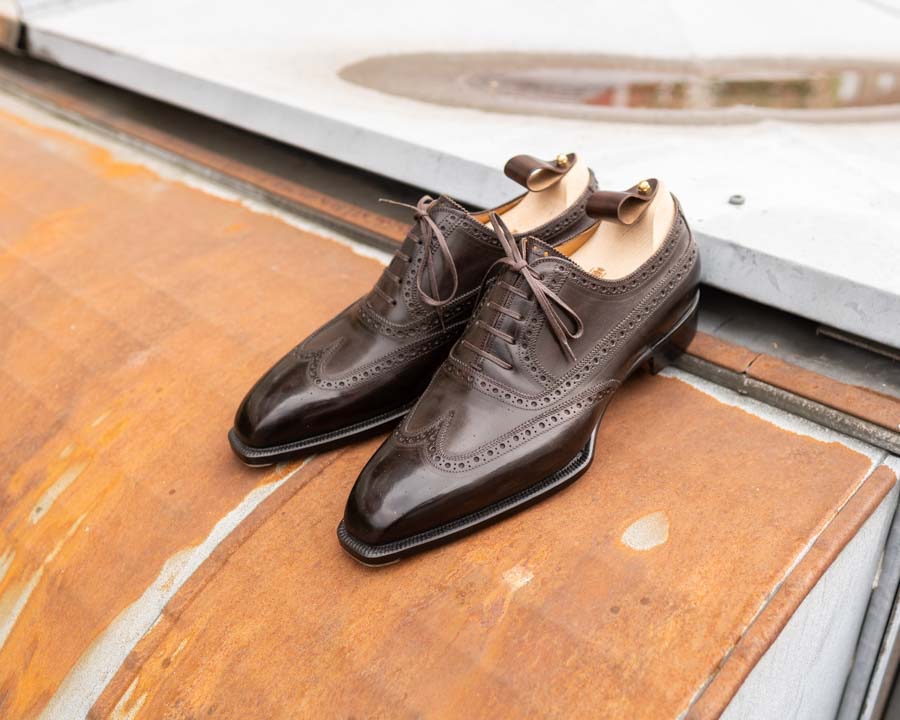

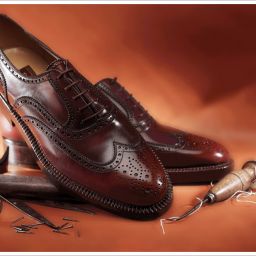

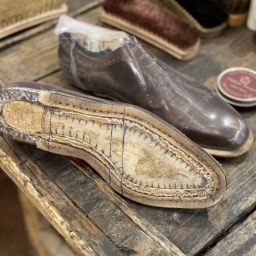


Great compilation!! Wish this was written when I started my collection. A very useful guide for those just starting!!
Thank you for reading!
The idea was to help people just starting or looking for some more information to have a nice list of things!
As far as I know Engineer Boots are named after the Railway Engineers that wore them in the beginning of the previous century: their task, among others, was to tend the fire in steam trains (= feeding coal to the fire).
The straps on the Harness Boots, again to the extend of my knowledge, are not decorative: their purpose is to hold the steel ring in place; the purpose of the ring is ankle protection while riding your motorcycle.
Finally, regarding the Indy boot: again as far as I know Harrison Ford wore the 405 model on the 3 Indiana Jones movies (there are only three Indy films, as there are only two Terminator films, all the rest is a parody). Alden stills names the model 405 (with some variations as 403, etc) but they advertise it as “Indy”.
Hi Harris,
there are many opinions and rumors about most of the shoes on the list hehe. I don’t pretend to be an expert, this is more of a showcase and how to recognize them, not a historical article.
Some say that these types of boots were used by welders. About Harness Boots, the few I have seen are decorative. I found the same info on the Indy as well. Rebranding referred to the popular way people still call it heh.
Thank you Kostas. Great job! A very useful guide for everyone. I disagree with you in only one topic: about spectators, I really love them in both colour combinations. and find them an elegant choice. In any case, it is acceptable to have different tastes in only one choice between the many that exist.
best wishes
Giannis
Thank you Yianni,
I don’t think spectators are necessarily ugly, but they are not my style. Or maybe my style and wardrobe has not matured yet enough to support this style. The ones I posted from Bemer are quite nice!
Wow what an article. I wish I saw this when I first started buying quality shoes. What are your thoughts on soft square lasts compared to round? When does the occasion call for one or the other? Is one better for a certain type of silhouette? I’m fairly new to the world of good dress shoes and I haven’t seen a definitive guide anywhere. My personal experience is that square toe seems to be more dressy perhaps and aggressive that works best with closer fitting suits (hem around 7.25 inches). I have the Carmina Rain last in black cap toe and it looks off in some of my first suits that fit looser (especially at hem around 8 inches) Round toe seems more versatile and could work with closer fitting and looser suits. Personally I find myself gravitating towards round toe because of those reasons and where I live a too aggressive look tends to standout negatively. For that reason I also have TLB’s Goya last. But for future shoes I am torn between the statement that a soft square last makes versus the versatility of a round toe. Plus what is available from shoe makers (seems to be easier to find soft square from Spanish brands). Thanks Kostas for everything you do.
Hey Joseph!
Thanks for reading! I have many more guides around the website and reviews for most of the shoe brands out there!
I love soft square lasts when done well they are my absolute favorites. They are a bit too “aggressive” for some people but I don’t think there is a right or wrong time to wear them. Maybe a rounder/almond toe for a less formal occasion.
Generally both make your feet look a bit more elongated so if you are not that tall it can be a great thing to use. I would say that indeed they are better for some more tapered suits. In your case I recommend wearing what you feel comfortable with and not worrying too much about other people!
Soft square lasts are found mostly in Spain, Portugal, France and Italy. The Asians are catching up and there are very few from the UK. For an example of a nice tasteful soft square check out today’s review article from Vass!
Best,
Kostas
Thanks for confirming what I thought. I’m a “youngerish” lawyer in small city so I have to keep it conservative. I’ll likely keep with round toes like the Goya although I love my carmina rains, they are my most comfortable shoes. I recently purchased the meermin Dani last, haven’t gotten it yet but looking forward to it. It’s their burgundy non cap toe which in your article you kind of put down but i think meermin is an exception to you saying that no respectful quality maker will produce this style. And to be fair though, I would have preferred a normal cap toe style but they don’t have that style in their linea maestro line and it fit the bill with everything else.
Everything sounds about right apart from the fact that I absolutely hate Meermin now and I can’t recommend the Linea Maestro line to anyone.
If you want a really unique yet classy black oxford, check this one out: https://www.thenobleshoe.com/products/carlos-santos-9899-handgrade-oxford-in-black-calf
Good luck with your journey!!!
Well written. Absolutely love this write up. I am a handmade shoe enthusiast & do have all the different dress shoes & boots & would have love a write up like this when I started collecting handmade shoes 18 years. Thank you!
Thank you very much for reading!
This is very comprehensive and I thought I knew a lot about shoes! I learnt quite a lot from this, especially some of the more unusual styles. A decent guide and very well written. Thanks!
Thanks Alex!
I got a lot more guides about construction, types of leather and actual shoemaking since I trained Bespoke.
Best,
Kostas
Most incredible article about men’s shoes I have ever come across. Much thanks!!!
Glad you enjoy!